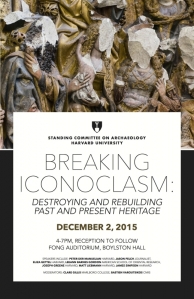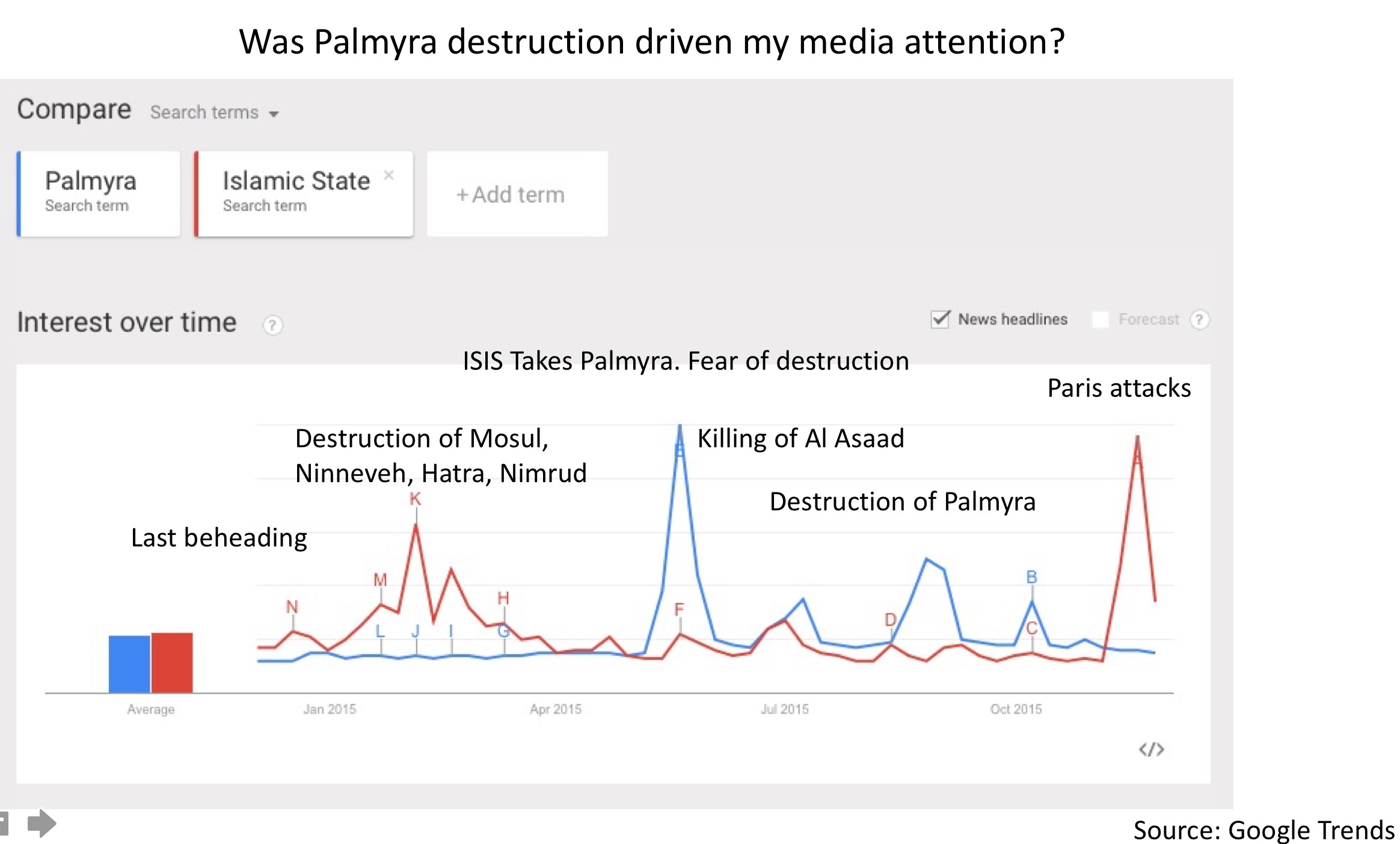Search the website:
-
BUY THE BOOK

AVAILABLE VIA
-
Recently
- 2/21/23 at the Natural History Museum of Utah: “Chasing Shiva: The Hunt for Looted South and Southeast Asia Antiquities” September 2, 2023
- UPDATED > USA vs One Ancient Mosaic: A Looted Syrian Masterpiece in Los Angeles May 26, 2018
- The Sidon Bull’s Head: Court Record Documents a Journey Through the Illicit Antiquities Trade September 24, 2017
- Hobby Lobby’s Legal Expert Speaks: “I can’t rule out…they used my advice to evade the law.” July 10, 2017
- UPDATED > Help Wanted: We’re Tracking Down Objects Sold By Nancy and Doris Wiener January 5, 2017
- UPDATED > Manhattan Dealer Nancy Wiener Arrested: Criminal Complaint Alleges Sweeping Conspiracy to Sell Stolen Asian Art Through Major Auction Houses December 21, 2016
- UPDATED > Inside the ISIS Looting Operation: U.S. Lawsuit Reveals Terror Group’s Brutal Bureaucracy of Plunder December 15, 2016
- The End of the Beginning: NGA Returns Kushan Buddha and Two Kapoor Objects September 18, 2016
- The Missing Link: Subhash Kapoor’s Suppliers in India Are (Finally) Getting Rolled Up July 3, 2016
- The Lessons of Palmyra: Iconoclasm in the era of Clickbait April 7, 2016
- UPDATED > Asia Week Arrest: Japanese Dealer Convicted Of Selling Stolen Art March 19, 2016
- Asia Week Raids: New Details on the Christie’s Seizures March 18, 2016
- Busted: Asia Week Raids Reveal Scope of Illicit Trade in Asian Art March 17, 2016
- The Crennan Report: The NGA’s Ex Post Facto Due Diligence Finds 22 “Questionable” Asian Antiquities February 17, 2016
- Operation Antiquity: Prison for Antiquities Dealer Behind Looting and Tax Fraud Scheme December 15, 2015
- Ball State’s Kapoor Return Reveals New False Provenance November 17, 2015
- The Seated Buddha Goes Home: Nancy Wiener and National Gallery of Australia Will Return Sculpture to India March 5, 2015
- The Kushan Buddhas: Nancy Wiener, Douglas Latchford and New Questions about Ancient Buddhas February 1, 2015
- Danti’s Inference: The Known Unknowns Of ISIS and Antiquities Looting November 18, 2014
- Hecht’s Footprints: Haverford College Opens Up About Source of Their Greek Vases November 4, 2014
-
Join 1,760 other subscribers
What we’re talking about
AAMD American Numismatic Society antiquities Aphrodite archaeology Arnold-Peter Weiss art crime Arthur Houghton Art of the Past Asian Civilizations Museum book review Cambodia Chasing Aphrodite Christies Cleveland Museum Dallas Museum of Art David Gill Dietrich von Bothmer Douglas Latchford Edoardo Almagià Elie Borowski Events FBI Gary Vikan Getty Museum Getty Villa Giacomo Medici Gianfranco Becchina Hugh Eakin illicit antiquities Immigration and Customs Enforcement India Italy J. Paul Getty Museum J. Paul Getty Trust James Cuno james grimaldi Jane Levine Jim Cuno Jiri Frel Khmer Kimbell Art Museum Koh Ker Loot looted antiquities looting Marion True Metropolitan Museum of Art Michaela Boland Michael Padgett museums Nancy Wiener National Gallery of Australia New York Review of Books Nomos AG Norton Simon Museum numismatics Princeton University repatriation Robert Hecht Robin Symes Ron Radford SAFE scandal Selina Mohamed Sicily Sotheby's Subhash Kapoor Tamil Nadu The Art Newspaper Timothy Potts Turkey Vijay Kumar Walters Museum of Art WikiLoot David Gill’s Looting Matters
David Gill’s Looting Matters- The Stern Collection in New York: Cycladic or Cycladicising?
- The Carlos Museum: Time to Reflect?
- Returns to Greece from Michael C. Carlos Museum
- Silver Pyxis Lid Returned from VMFA
- Gnathian Askos Returned from Virginia MFA
- Virginia MFA Returns Antiquities
- Bubon Bronzes Returning to Türkiye
- The Parthenon Sculptures and the political arena
- The Wild Goat Plate Fragment and Francavilla Marittima
- The Michael C. Carlos Museum and the Becchina Archive
 Paul Barford’s Portable Antiquities and Heritage Issues
Paul Barford’s Portable Antiquities and Heritage Issues- Yet Another Rusty Helmet Just Surfaces on the Antiquities Market
- Unesco verifies damage to 43 cultural heritage sites in Gaza
- Another Getty Trophy Piece Goes Back to Turkey. Museum-Speak Translation
- Ram Raid at Antiquities Auction House
- Oh, I see
- Public Archaeology: Whether to laugh or Cry
- Another one, "Eyes to See" = "Looks Like"
- What Happens When you Do Public Archaeology?
- Hancock and Dibble: Public Archaeology versus Amateurish Theorising and gaslighting
- Crimean Site Damaged by Occupant in Infrastructure Works
 Derek Fincham’s Illicit Cultural Property
Derek Fincham’s Illicit Cultural Property- Alleged Bubon Smuggling Network Widens
- Marlowe on the Real Issue with the Glyptotek Head
- 27 Objects Seized From the Met
- Smash and Smash at the Dallas Museum of Art
- Elizabeth Marlowe’s Review of ‘The Brutish Museum’
- The Terrific Pandora Papers Looted Art Article
- Italian Senate renews call for return of the ‘Bronze Statue of a Victorious Youth’
- Psychics, Bowie knives, fake Alamo artifacts: New Book out today on how Texas can’t shake the Alamo
- Online Symposium on the Benin Bronzes Friday Apr. 9
- University of Aberdeen will repatriate a Benin bronze to Nigeria
 Conflict Antiquities
Conflict Antiquities- Russia was ‘doomed to expand [its] aggression’ against Ukraine: Cultural property criminals’ responses to the invasion and occupation of the Donbas since 20th February 2014
- propagandist fighter Maxim Fomin and the supply of metal detectors by artefact hunters for mine clearing by Russia’s forces in Ukraine
- Destructive Exploitation and care of Cultural Objects and Professional/Public Education for sustainable heritage management (DECOPE)
- a very low estimate of metal-detecting in the United Kingdom, according to the Portable Antiquities Scheme
- loot and forgeries from Eastern Europe on the market in Western Europe, regardless of Russia’s war on Ukraine
- artefact-hunting in drug plantations and by cannabis-cultivators in Ukraine (around 2014)
- attitudes to personal and public health precautions among artefact-hunters amid the Covid-19 pandemic
- human rights worker and anti-imperialist fighter Maksym Butkevych has been captured by Russia’s invading forces
- Russia’s destruction of Ukraine’s cultural property is proof of its intent to commit genocide.
- Russia is subjecting cultural heritage workers and other civilians to the war crime of forced military labour.
 The Association for Research into Crimes against Art
The Association for Research into Crimes against Art- Georgia's Prosecutor Pursues Criminal Charges Against Four Nationals in Book Theft Investigation
- When a money launderer's art collection comes up for auction
- Christ Church Picture Gallery painting by Baroque painter Salvator Rosa recovered in Romania
- Spain's antiquities dealer arrest and the importance of facts-based reporting
- Arrest made in Spain on Egyptian antiquities smuggling case.
- Stolen Saint: Ukraine Authorities Retrieve the Holy Warrior Bas-Relief of Saint Demetrius of Thessaloniki from an Online Auction
- Judgment entered in favor of Plaintiff (Hobby Lobby Stores, Inc). against Defendant (Dirk D. Obbink)
- 18 May 2024 - 2024 New Zealand Art Crime Symposium - Art Crime Research Today
- Girolamini Library Theft - Convictions and acquittals in the network of every bookworm's antichrist
- Isabella Stewart Gardner Museum Marks 34th Anniversary of Infamous Art Theft
Meta
UPDATED > USA vs One Ancient Mosaic: A Looted Syrian Masterpiece in Los Angeles
Rampant looting across Syria during its prolonged civil war has been well documented through satellite imagery and on the ground reports, but evidence that the looted antiquities are emerging in the Western art markets has, until recently, been scarce.
That is starting to change. Last month, Spanish investigators arrested a Barcelona antiquities dealer, Jaume Bagot, for alleged trafficking in looted antiquities sold by ISIS. Last week, Italian authorities seized objects said to have been looted in Egypt by ISIS affiliates, though details have yet to emerge. And in May 2017, the Wall Street Journal reported that the New York gallery Phoenix Ancient Art was entangled in an investigation of ISIS loot, a claimed the owners say is false and libelous.
This week, the issue hit home when federal authorities in Los Angeles moved to forfeit a 1 ton, 18-foot long ancient mosaic of Hercules’ 11th labor that was seized in 2016 from a naturalized Syrian man living in Palmdale, CA. The government alleges the massive mosaic was looted in Syria and smuggled into the United States with falsified documents. (See complaint below.)
The FBI has been investigating the owner of the mosaic, Mohamad Yassin Alcharihi, since 2015, when he hired the company Soo Hoo Customs Brokers to import the mosaic through the port of Long Beach. The mosaic was imported along with two other mosaics and 81 modern vases and declared as “ornamental art” and “ceramic tiles” with a total value of $2,199.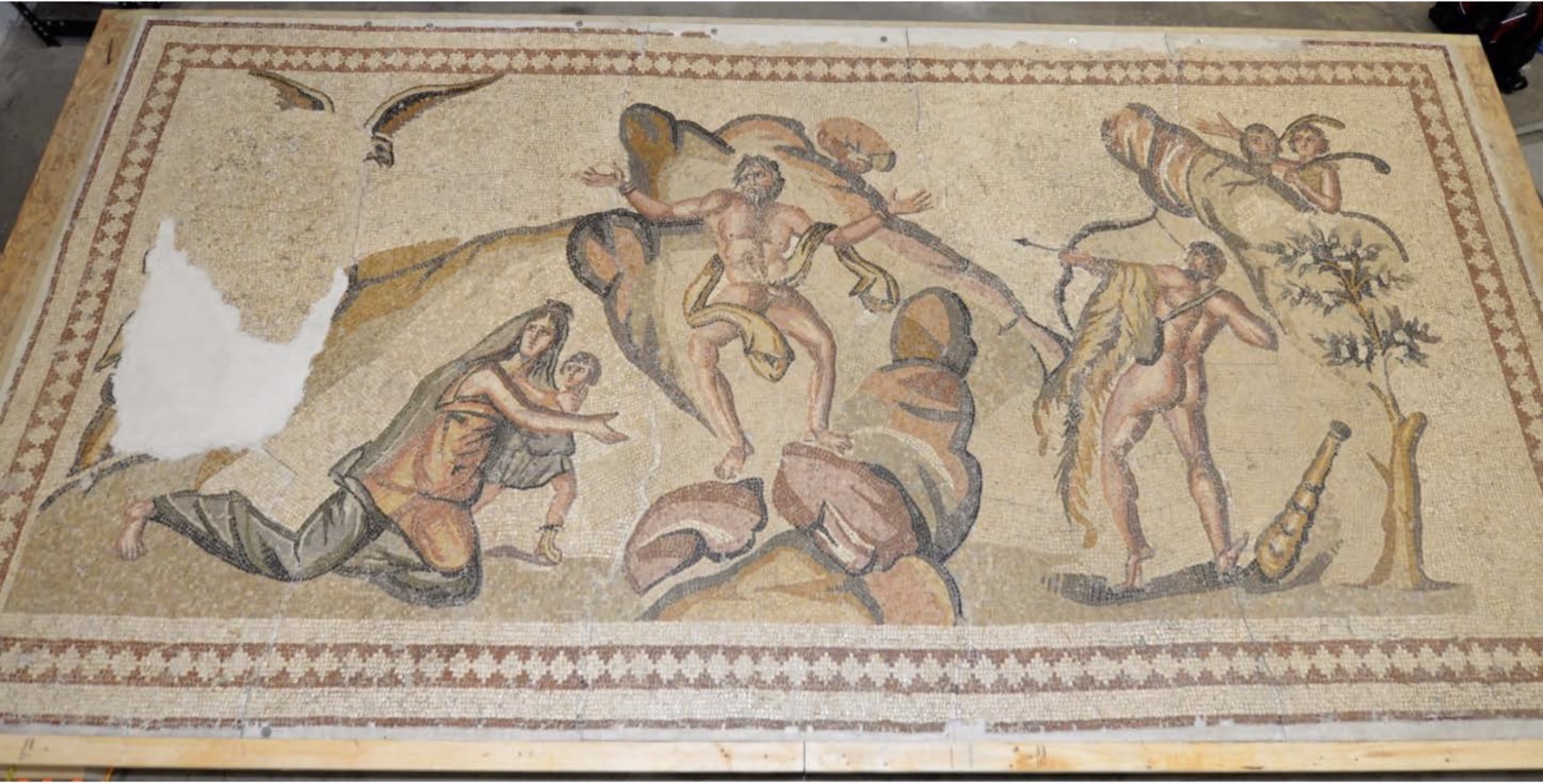
Alcharihi said he had purchased the mosaics and vases from Ahmet Bostanci in Defne-Hatay, Turkey earlier that year. An invoice shows the sale took place June 4, 2015.
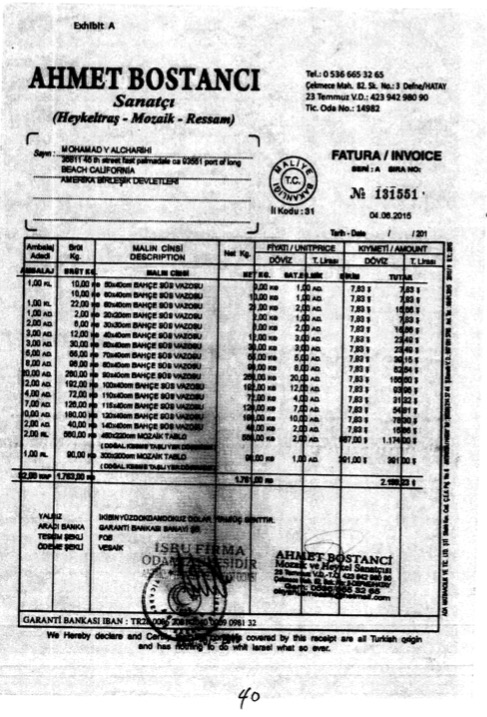
But another document found in his house claimed Alcharihi had purchased the rolled up “mosaic carpet” in a 2009 yard sale and had been in the seller’s family since the early 1970s. When interviewed, the seller said she was Alcharihi’s neighbor and had written the receipt at Alcharihi’s request to document her sale of a small carpet, not a 1 ton mosaic. It appears this false provenance story was intended to cover the mosaic’s true origins.
Federal investigators interviewed two artists who helped restore the mosaic. Alcharihi told the first, an artist who had done work for New York City Metro, that the mosaic had been “peeled off a floor 25 years ago,” rolled up and stored while Alcharihi tried to get it out of Turkey. The second artist spent 20 days in Alcharihi’s Palmdale garage restoring the mosaic.
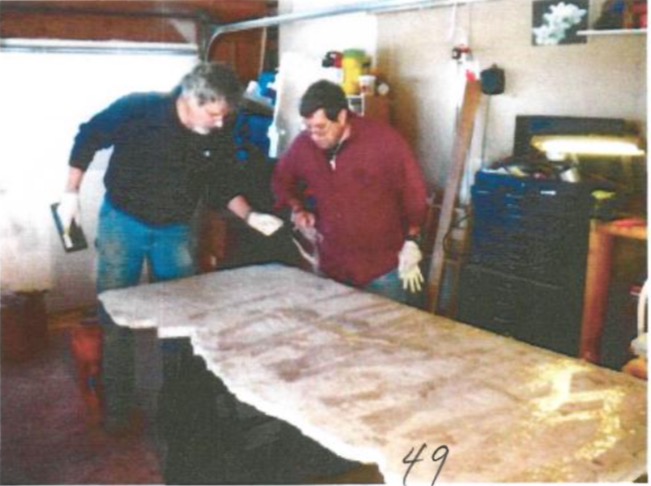
Alcharihi submitted photos of the mosaic to an auction house, including one that appeared to show the mosaic in the ground. An expert for the government examined the photos, and later the mosaic itself, and concluded it was likely Byzantine with iconography consistent with mosaics found near Idlib, Syria.
Idlib, in the northwest corner of Syrian near the Turkish border, has been at the center of fierce fighting between President Bashar al-Assad’s government forces and opposition fighters and ISIS at times since 2011. In late 2014 the city was the focus of a rebel offensive against government forces that included Al Nusra, an Al Qaeda affiliated rebel group.
Alcharihi told investigators he worked in sales and sold salvaged cars through a cousin in Togo, Africa. He said he had bought the mosaics from a well known artist in Turkey who was Syrian and lives in Saudi Arabia, but traveled often to Turkey. He claimed to have paid $12,000 for the mosaic and vases and admitted undervaluing them to avoid import duties, court records show. He also admitted the mosaic was ancient, unlike the modern vases.
In emails seized by authorities, Alchahiri told a prospective buyer a different story: “The mosaic piece was found in a destructed historical building in Ariha county in Idleb city, North western of Syria” on land owned by his family. The picture of the mosaic was taken in situ in 2010 by an expert who removed the mosaic “after obtaining a removal and transfer permit” and sent it to Turkey for restoration.
In the email, Alchahiri included an image of the mosaics in situ:
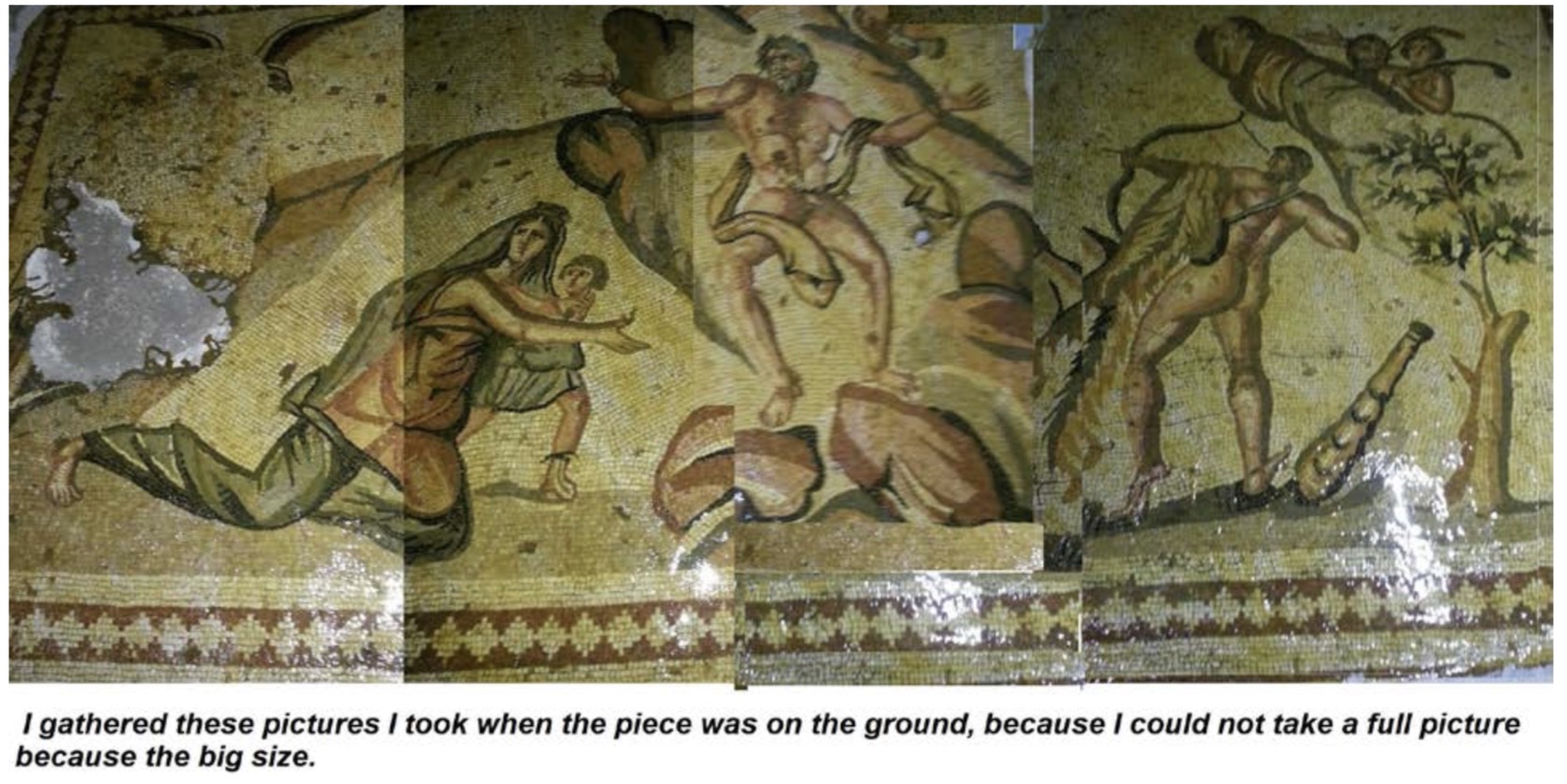
Alchahiri’s associate obtained an estimate of $100,000 to $200,000 market value for the mosaic and sent pictures of it to an unnamed UK auction house. When the auction house inquired about its provenance, the associate was forthcoming: Syria. “As long has you have documentation/proof that they left Syria before 2010, we might be able to accept these if they are legally shipped to the UK.,” the auction house responded, later offering an estimate of 40,000 to 60,000 British Pounds, or USD$60,000 to $91,000.
The complaint does not say what came of the proposed sale, nor explain why it took two years after the seizure for federal officials to file a forfeiture complaint in Los Angeles this week.
UPDATE: In a petition filed in October 2016, Alchahiri, acting as his own attorney, challenged the government seizure and submitted a raft of documents to support his claim that it was legally exported.
Alchahiri objected to the seizure on several grounds, alleging repeatedly that the FBI’s only basis for the seizure was “Islamaphobia and racism.” Some of his assertions are difficult to understand, such as his claim that “The Mosaic makes a certain statement about Greek Mythology which is muffled and stifled by the illegal seizure of the Mosaic and the continued refusal to return such property for display to the public.”
The 70+ pages of attachments to his petition offer new details on the case, including photos of the extensive restoration done by Stephen J. Miotto of Miotto Mosaics Art Studios.
A list of items seized during the FBI raid includes a reference to “Heritage Auctions,” a Dallas TX based auction house with an office in London that specializes in ancient coins.
In another document, a lawyer for Alchahiri states he is “a naturalized citizen of the UnitedStates, originally from Syria, who operates the business of importing, buying and selling ancient artifacts from overseas.” Alchahiri “became interested in importation and sales of artifacts in about 3 years due to good connections and his knowledge of people working in cheap labor departments of organizations involving artifacts.”
In the same letter, the lawyer notes that Alchahiri was concerned about documents the FBI found in his safe “may be misconstrued and may be improperly viewed as possibly incriminating.”
“The purpose was to mislead non-serious buyers and possible thieves who had already begun to inquire about the valuable mosaic, subsequent to its restoration,” the lawyer stated.
The letter appears to be referring to the false provenance documents described in the complaint, which purport that Alchahiri bought the “mosaic carpet” in a 2009 yard sale from his neighbor, who claimed to have had it in the family since 1970.
Here are the court filings in USA vs. One Ancient Mosaic:
Posted in News
Tagged Ahmet Bostanci, Jaume Bagot, looting, Los Angeles, Mohaman Yassin Alcharihi, Mosaic, Soo Hoo Customs Brokers, Syria
The Sidon Bull’s Head: Court Record Documents a Journey Through the Illicit Antiquities Trade
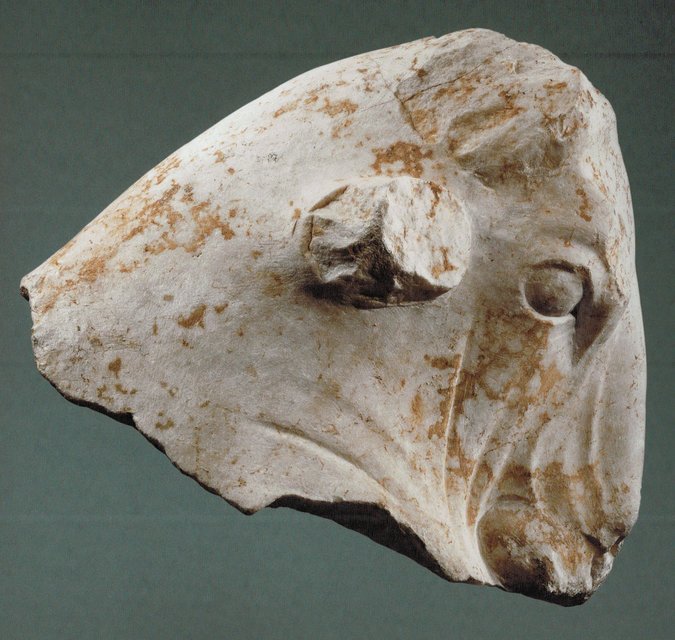 A remarkable document filed with New York’s Supreme Court on Friday reconstructs the journey of an ancient sculpture of a bull’s head from its theft during the Lebanese civil war through the shadowy corners and winding pathways of the international antiquities black market.
A remarkable document filed with New York’s Supreme Court on Friday reconstructs the journey of an ancient sculpture of a bull’s head from its theft during the Lebanese civil war through the shadowy corners and winding pathways of the international antiquities black market.
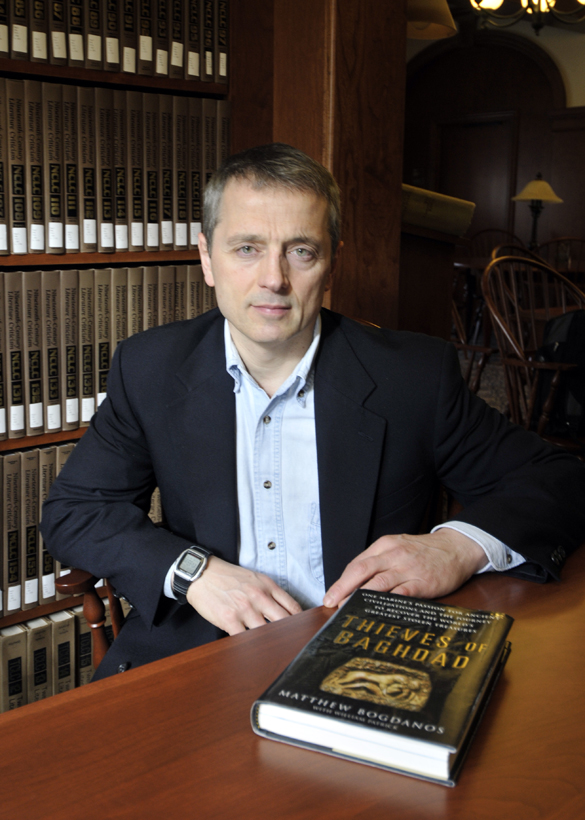 The filing, an application for a turnover order filed by Deputy DA Mathew Bogdanos, recounts a Grand Jury investigation that traced the stolen relic through a who’s who of the antiquities trade before ending up on loan at the Metropolitan Museum of Art, where it was seized in July.
The filing, an application for a turnover order filed by Deputy DA Mathew Bogdanos, recounts a Grand Jury investigation that traced the stolen relic through a who’s who of the antiquities trade before ending up on loan at the Metropolitan Museum of Art, where it was seized in July.
The 66-page filing is worth reading in full, as it bristles with insights into the antiquities trade that Bogdanos, the author of Thieves of Bagdad, has collected over more than a decade investigating antiquities trafficking networks. It is also a testament to the type of dogged investigation required to uncover the true history of a stolen antiquity.
Bogdanos’ investigation included the use of Grand Jury subpoenas, search warrants, interviews with witnesses in several countries and thousands of pages of shipping documents, customs forms and email correspondence.
“Nonetheless, even this investigation…has been unable to illuminate those well-appointed shadows where money changes hands and legitimate, but all-too-inconvenient, questions of the provenance and ownership history of the objects are frequently considered outre and ever so gauche,” Bogdanos writes. “Indeed, because so many shadows remain, and because the farther back we go the darker and more impenetrable are those shadows, it is best to trace the possession of the Bull’s Head backward…”
Anyone familiar with investigations of Mediterranean smuggling networks over the past two decades will recognize the dozen names associated with the object’s past.
The following summary of that shadowy journey does not do justice to the tale, but highlights the key players:
July 8, 1967: The bull’s head was excavated from the Temple of Eshmun in Sidon, Lebanon, by French archaeologist Maurice Dunand as part of a state-sponsored excavation.
1979: Amidst the raging Lebanese civil war, the bull’s head and other artifacts from Eshmun were transferred to Beirut and then to a storage area of the Byblos Citadel for safekeeping.
1981: Armed members of the Phalangist paramilitary group seized objects from the Citadel, including the bull’s head. After negotiations with the antiquities directorate, the Phalangists return many of the objects to the Citadel. But the bull’s head and dozens of other objects are not among them and disappear into the black market.
1980s: The Bull’s Head is associated with the George Lotfi Collection of Beirut and Paris and with Frieda Tchacos in Zurich (Nefer Gallery), according to a subsequent claim by the Met’s curator of ancient art Joan Mertens. Her source for this information is never clarified or documented.
April 11, 1991: Four sculptures stolen from Eshmun appear in an auction by the Numismatic & Ancient Art Gallery in Zurich. They are seized and returned to Lebanon.
December, 1994: Sotheby’s offers a male torso and a sarcophagus fragment from Eshmun for sale. Both are eventually seized and returned to Lebanon. Several more Eshmun objects are recovered over the years.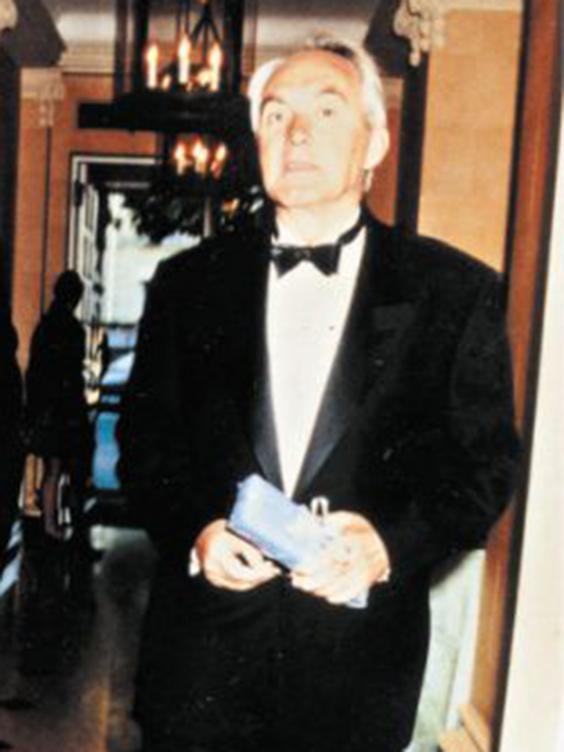
May 18, 1996: The Bull’s Head re-appears in shipping documents and was delivered to London antiquities dealer Robin Symes’ New York penthouse at the Four Seasons’ Hotel on 57th Street.
As Bogdanos notes, “There is not a single piece of paper known to exist on or about the Bull’s Head (C-17) between its disappearance from the basement storage room of the Byblos/Jubayl Citadel on August 14, 1981, and its brief appearance in the Transcon invoices in the summer of 1996…A neon sign flashing “stolen” would have been more subtle and less insidious.”
 November 27, 1996: Symes sells the Bull’s Head for $1.2 million to Lynda and William Beierwaltes of Colorado, who display it in their dining room. While Symes assures them the object is authentic, as Bogdanos notes, “there was not a whisper-not even the faintest hint of a whisper about whether it was a lawful antiquity. Indeed, the lawfulness of the Bull’s Head (C-17) does not appear to have been part of any documented conversation between the Beierwaltes and Symes.” The Bull’s Head appears on the market “like Athena full-grown from the brow of Zeus,” Bogdanos writes, one of several flourishes in his filing.
November 27, 1996: Symes sells the Bull’s Head for $1.2 million to Lynda and William Beierwaltes of Colorado, who display it in their dining room. While Symes assures them the object is authentic, as Bogdanos notes, “there was not a whisper-not even the faintest hint of a whisper about whether it was a lawful antiquity. Indeed, the lawfulness of the Bull’s Head (C-17) does not appear to have been part of any documented conversation between the Beierwaltes and Symes.” The Bull’s Head appears on the market “like Athena full-grown from the brow of Zeus,” Bogdanos writes, one of several flourishes in his filing.
1998: The Bull’s Head and other objects in the Beierwaltes collection are displayed in an article in House and Garden. Christos Tsirogiannis, a forensic archaeologist specializing in identifying illicit antiquities, identified many looted antiquities in the Beierwaltes collection by matching the photographs in the article to photographs of looted antiquities contained in dealer archives.
2004: The Beierwaltes ask Max Bernheimer, Head of Christi.e’s Ancient Art & Antiquities Department, to appraise their antiquities collection. He appraised 115 objects in the collection at $51.5 million but never offered it at auction. Symes was revealed as their main supplier, the source of 97 of the 99 objects that listed a prior owner. “Symes was not just their main supplier, he was to all intents and purposes their only supplier: the direct, the essential, and clearly much-used link in a supply chain that started with the tombaroli and ended with the Beierwaltes,” Bogdanos writes.
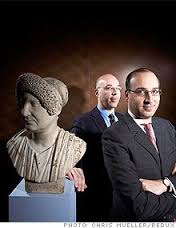 2005: The Beierwaltes approach Hicham Aboutaam at Phoenix Ancient Art about selling the Bull’s Head and other antiquities in their collection, which is estimated to be worth $95 million. Phoenix appraises the value of the Bull’s Head at $1.5 million.
2005: The Beierwaltes approach Hicham Aboutaam at Phoenix Ancient Art about selling the Bull’s Head and other antiquities in their collection, which is estimated to be worth $95 million. Phoenix appraises the value of the Bull’s Head at $1.5 million.
2006: Phoenix ships the Bull’s Head and other objects from the Beierwaltes to Geneva, where it is kept in the Geneva Freeport. “According to Hicham Aboutaam, and as is standard procedure with shipments to the Freeports, and hence part of the sine qua non of their existence, the Bull’s Head went directly from the Geneva airport in a Swiss-customs-padlocked truck to the Geneva Freeport. And it left the Freeport the same way.”
2008: Phoenix requested a search for the Bull’s Head in the Art Loss Register database of stolen art. The ALR had been provided details about the stolen Bull’s Head in 2000 but mysteriously failed to enter it into their database of stolen art. ALR issued a certificate for the object — a fact that, in Bogdanos’ words, “highlight(s) the dangers of relying on an ALR search and nothing more for provenance research.”
2008: Phoenix Ancient Arts publishes images of the Bull’s Head in their Geneva catalog in advance of showing the Bull’s Head at the 24th Biennale des Antiquaires at the Grand Palais in Paris. After the Paris show, it is shipped back to Geneva.
September 2009: The Bull’s Head is shipped to New York, where hedge fund billionaire Michael Steinhardt expressed an interest after seeing it in the Phoenix catalog but claimed in an email he was too “broke” to buy it at the time.
August 10, 201O: Steinhardt acquired the Bull’s Head for $700,000 and left it on display at Phoenix Ancient Art’s New York Gallery.
October 2010: The Bull’s Head is loaned to by Met by Steinhardt through Phoenix Ancient Art Gallery. The only reference to its provenance is a single line of six words: “Ex-American private collection, collected in 1980’s-1990’s.” When the Met presses for more detail, Phoenix says The Beierwaltes aquired it from Symes.
2014: The Beierwaltes declare bankruptcy, declaring that their “primary business for much of their adult lives has been the acquisition, management and sale of an extremely extensive and valuable body of art works…[in]…a category of art known as antiquities.”
April 2014: Carlos Picon, the Curator in Charge of the Met’s Greek and Roman Department, noticed that the Bull’s Head on loan from Steinhardt appeared to be the same bull’s head missing from the Eshmun excavations. The object was removed from display and Aboutaam was notified.
April 16, 2014: Given the revelation, the Beierwaltes re-acquired the Bull’s Head from Steinhardt for $560,000 ($700k minus Aboutaam’s 20% commission). Steinhardt receives a piece of equal value from Aboutaam.
October 2016: Met General Counsel Sharon Cott writes to Steinhardt saying the Met intended to notify Lebanese authorities about the stolen Bull’s Head. William Pearlstein, the Beierwaltes’ attorney, acknowledged that the bull’s head was likely the one found in Eshmun but asked the Met not to contact authorities.
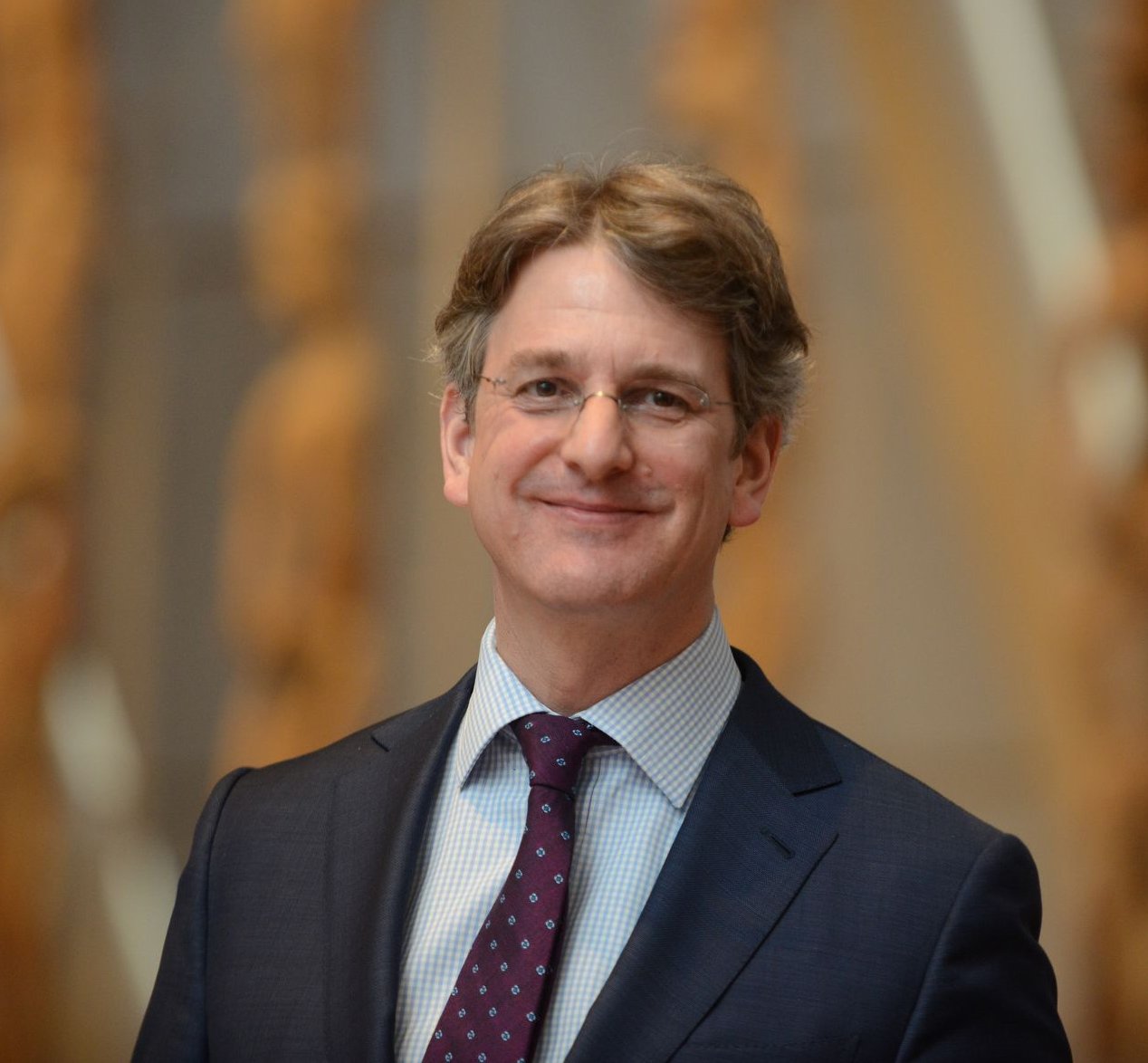
Dec. 5 2016: Met director Thomas Campbell notifies Lebanon that the bull’s head on loan to the museum appears to come from Sidon.
January 10, 2017: Sarkis Khoury, the Lebanese Director General of Antiquities, requests the return of the stolen Bull’s Head. He also writes to the Beierwaltes with a similar demand in March.
June 2017: Amid the District Attorney’s investigation, counsel for the Beierwaltes filed a pre-emptive lawsuit against the Lebanese Republic and the Manhattan DA’s office seeking to prevent the seizure of the bull’s head.
July 7, 2017: Acting on the request from Lebanese authorities, the DA’s office seized the Bull’s Head from the Met.
The full court filing can be found here and below:
Posted in News
Tagged Art Loss Register, Carlos Picon, Christies, Christos Tsirogiannis, Frieda Tchakos, Geneva Freeport, Hicham Aboutaam, Lebanon, Lynda and William Beierwaltes, Manhattan District Attorney, MAthew Bogdanos, Max Bernheimer, Metropolitan Museum of Art, Michael Steinhardt, Phoenix Ancient Art, Robin Symes, Sarkis Khoury, Sharon Cott, Sotheby's, Temple of Eshmun, Thomas Campbell
Hobby Lobby’s Legal Expert Speaks: “I can’t rule out…they used my advice to evade the law.”
In July 2010, Steve Green, president of the Hobby Lobby chain of craft stores, travelled to the United Arab Emirates to inspect a massive hoard of ancient artifacts.
A year earlier, Green and his advisor Scott Carroll had begun building one of the world’s biggest collections of biblical relics and manuscripts. In less than 24 months, the two would acquire more than 40,000 objects, building The Green Collection into “the newest and largest private collections of rare biblical texts and artifacts in the world.”

Steve Green and his antiquities advisor Scott Carroll (NY Times)
Those objects will form the core collection of the Museum of the Bible, a 430,000-square-foot building that Hobby Lobby is building blocks from the National Mall. When it opens in the fall of 2017, its mission is to “bring the bible to life.”
Pitching Green and Carroll that day in the UAE warehouse were two Israeli antiquities dealers and a third local dealer (all unnamed in the complaint.) They were offering some 1,500 cuneiform tablets, 500 cuneiform bricks, 3,000 clay bullae, 35 clay envelope seals, 13 extra-large cuneiform tablets and 500 stone cylinder seals, according to a federal forfeiture complaint filed last week.
 The sample of those objects made available for inspection that day bore several hallmarks of the illicit antiquities trade.
The sample of those objects made available for inspection that day bore several hallmarks of the illicit antiquities trade.
They were “displayed informally,” according to the complaint –– “spread out on the floor before him, arranged in layers on a coffee table, and packed loosely in cardboard boxes, in many instances with little or no protective material between them.”
They belonged not to any of the three dealers present but to a fourth, who claimed they had come from his “family collection” in Israel. As for their provenance, the dealers claimed the objects had been “legally acquired in the late 1960s” from “local markets.” Bizarrely, they also said the objects had been sent to Mississippi for storage in the 1970s and had most recently been in Washington DC before being shipped to the UAE for that day’s inspection.
The final red flag: the objects were being sold at a deep discount. Carroll thought the objects were worth approximately $11.8 million, but were being offered for sale that day for just $2 million.
After Green got back to Oklahoma City, where Hobby Lobby is based, the company’s in house lawyer contacted an expert in cultural property law. According to the complaint, in August 2010 that unnamed expert travelled to Oklahoma and gave a presentation to Green, Carroll and the company lawyer on the laws governing the purchase and importation of cultural property.
The presentation is cited prominently in the government’s recital of evidence leading to last week’s civil forfeiture of 5,500 ancient objects that Green bought in December 2010 for $1.6 million.
Responding to the seizure, Green released a statement saying he “did not fully appreciate the complexities of the acquisitions process.”
An interview with Green’s expert, however, suggests a different story: Green and his advisors were given detailed guidance from one of the leading legal minds on antiquities acquisitions, and then chose to ignore it.
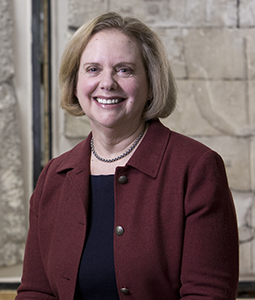 I have confirmed that Green’s unnamed expert was Patty Gerstenblith, one of the country’s leading experts in cultural property law and a professor at DePaul University.
I have confirmed that Green’s unnamed expert was Patty Gerstenblith, one of the country’s leading experts in cultural property law and a professor at DePaul University.
I reached Gerstenblith yesterday while she was in The Hague participating in an Expert Consultation on Policy on Cultural Property at the Office of the Prosecutor of the International Criminal Court. What follows are excerpts from our conversation about her work for Hobby Lobby, edited lightly for length and clarity.
Chasing Aphrodite: How did you start working as an advisor for the Greens?
Patty Gerstenblith: The in house counsel – I’d rather not name the person, as they’re not named in the complaint – asked if I would be willing to explain the legal issues involved in importing cultural works and antiquities, what laws would pertain. This was 7 years ago.
They were planning to build the collection. I had never heard of Hobby Lobby but saw they had recently acquired a medieval manuscript that had almost singlehandedly changed the market. I agreed to advise them.
CA: Were you hired as legal counsel?
PG: No. I was not engaged as an attorney, and I didn’t act as their attorney. I acted as an expert and consultant. They compensated me. [Gerstenblith declined to state how much she was paid for the engagement.]
CA: Can you describe the presentation you gave to Hobby Lobby executives in Oklahoma City on August 10, 2010?
PG: It was a board room or seminar room. There were between 10 and 15 people there. The in house counsel, and the advisor. Steve Green was there to my memory. I don’t know if he stayed for the entire presentation. I have no idea who the other people were.
I gave them very general information about laws that applied to importation of antiquities, the same I would do in a public lecture. I went through the National Stolen Property Act, declarations of value and country of origin….
CA: What was their reaction to your presentation?
PG: I can’t say they reacted one way or the other. They didn’t seem surprised or upset, which in hindsight is kind of surprising. The impression I had at the time was that they were only considering buying antiquities. I had no idea until I read the complaint [released last week] that this was already in process. They had already earlier in July, before I talked to them, looked at cuneiform tablets. You would think if I’m talking about… you have to do this and that and they’re already in negotiations, they would have had some reaction to what I said. I’m pretty mystified why they bothered to have me do this for them.
CA: Did they ask specifically about laws pertaining to Iraq or the Middle East?
PG: At the time I knew their reputation in terms of their interest in things that pertained to the bible. After my presentation, we had a little lunch. That’s possibly when I found out their interest in cuneiform tablets.
CA: The complaint says you sent a written report to Hobby Lobby on October 19, 2010. What was the purpose of that memo? Can you provide us a copy of it?
PG: When I finished the presentation, the in house counsel asked me to write up a summary. It took me a while to get to it. It summarized what I had presented, but at this point I had been aware they were thinking of acquiring things from Iraq so made sure this was included in the memo.
Gerstenblith said she could not provide a copy of her memo on the law, but the federal complaint quotes from it, in part, as follows:
I would regard the acquisition of any artifact likely from Iraq (which could be described as Mesopotamian, Assyrian, Akkadian, Sumerian, Babylonian, Parthian, Sassanian and possibly other historic or cultural terms) as carrying considerable risk. An estimated 200-500,000 objects have been looted from archaeological sites in Iraq since the early 1990s; particularly popular on the market and likely to have been looted are cylinder seals, cuneiform tablets . . . . Any object brought into the US and with Iraq declared as country of origin has a high chance of being detained by US Customs. If such an object has been brought into the US in the past few years and was not stopped by US Customs, then you need to examine the import documents to see if the country of origin was properly declared; an improper declaration of country of origin can also lead to seizure and forfeiture of the object.
The complaint continues: “The Expert’s memorandum further advised Hobby Lobby that cultural property looted from Iraq since 1990 is specifically protected by import restrictions that carry criminal penalties and fines. The Expert’s memorandum was received by In-house Counsel but was not shared with Hobby Lobby’s President, Consultant, Executive Assistant, International Department, outside customs brokers, or anyone involved in the purchase and importation of the Defendants in Rem.”
PG: They didn’t even pass my advice on. I was surprised to learn that in the complaint. Why did they both having me do this? The memorandum I wrote was never circulated beyond in house legal counsel, and they were already in the process of acquiring these objects.
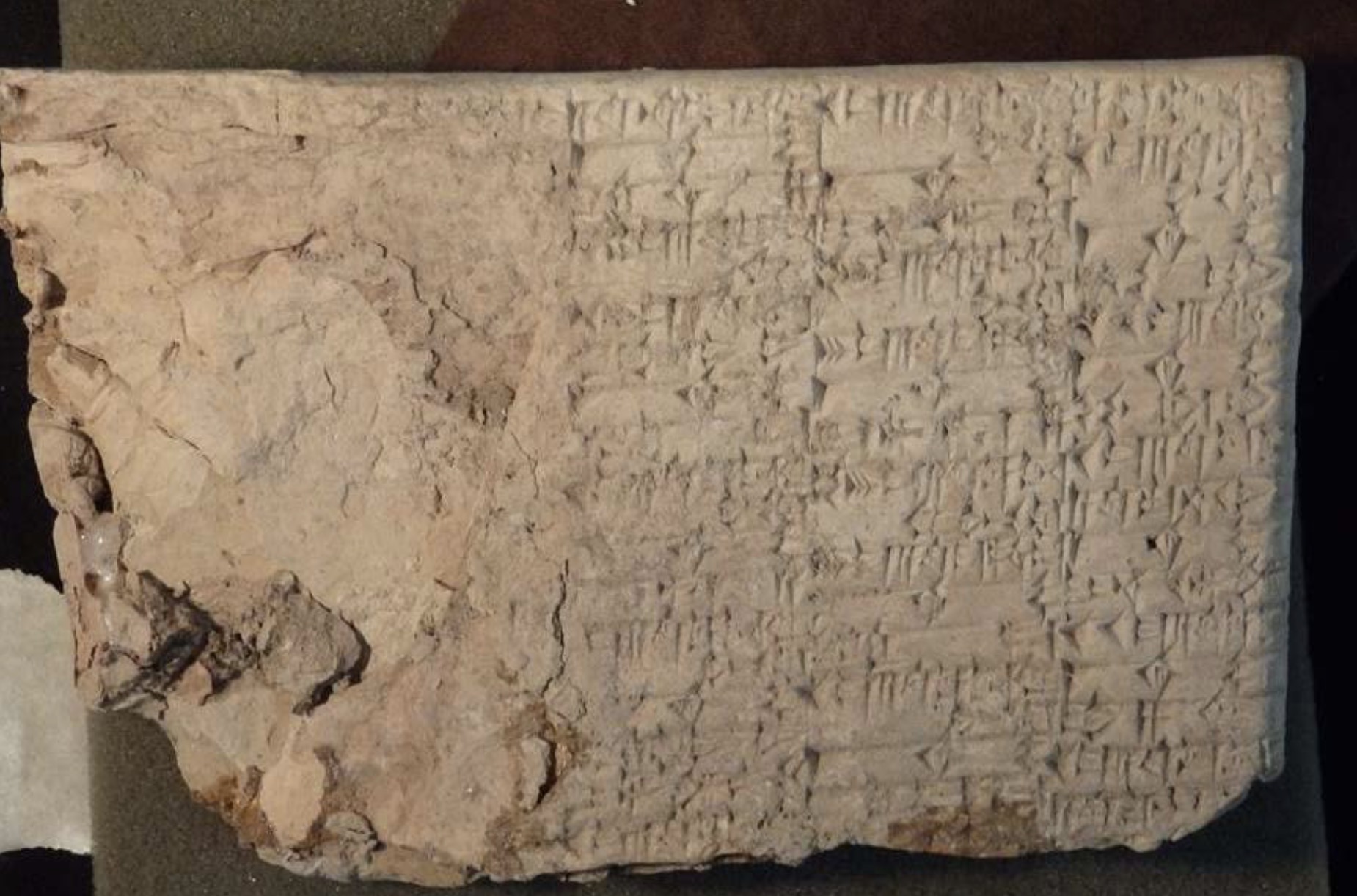 CA: Was there any follow-up? Did they ask you to review any specific cases or documents after that?
CA: Was there any follow-up? Did they ask you to review any specific cases or documents after that?
PG: My involvement as an expert for Hobby Lobby ended after I gave them the memo. There was no follow-up, no review of specific cases or documents or any specific objects pertaining to importation. I never evaluated anything for them.
CA: According to the federal complaint, they later did the very things you warned against. Do you think they used your advice to break the law rather than to follow it? In other words, do you feel used?
PG: I suppose one can’t rule that out. Which would be very upsetting to me. I can’t rule that out. My goal was to discourage them from doing the wrong thing by telling them all the wrong things they could do. I thought they would not want to do those things. I can’t rule out it was all the opposite…that they used my advice to evade the law as opposed to follow the law.”
CA: Many have asked: why were there no criminal charges in this case? As a law professor, what’s your answer?
PG: There is a lot here that does read as a red flag. Shipping boxes to various locations. Mislabeling cuneiform tablets as ceramic tiles. These have in many cases been the hallmarks of intentional violations of customs laws.
Yes it looks like there was criminal activity, but its not clear who committed the crime. The government would have to prove criminal knowledge beyond a reasonable doubt. A jury would have to find that these people knew not only what the law was but also that they were responsible for how the stuff was falsely labeled when it was imported. I have to assume the government felt it would have difficulty proving who knew what.
One difference from the Schultz case is the number of people involved. Schultz was doing it all himself. Here there were so many people involved, they’ve created plausbile deniability as to who knew what.
CA: In your view, what deterrent effect do seizures like this have without criminal prosecutions?
PG: The trend has, unfortunately, been away from prosecution. There’s a tendency to be happy with forfeiture. These cases in general have very little deterrent effect. Most collectors and dealers, having to return an object, thereby loosing the vaulue, is not really a big financial loss. In the case of Hobby Lobby, not at all. Therefore, its not a deterrent. I have come to believe that criminal prosecution is the only effective deterrent. I’m not the only person who’s made this comment.
UPDATED > Help Wanted: We’re Tracking Down Objects Sold By Nancy and Doris Wiener
In the wake of the arrest of the Manhattan antiquities dealer Nancy Wiener, we’re teaming up with our friends at the India Pride Project to track down the ancient objects she and her mother Doris Wiener sold to museums and private collectors around the world. And we need your help.
 Prosecutors allege the two conspired for decades with a network of smugglers and middlemen to obtain looted and stolen antiquities from across Asia. Many of those objects passed through auction houses before being purchased by museums and private collectors. (See our earlier coverage here.)
Prosecutors allege the two conspired for decades with a network of smugglers and middlemen to obtain looted and stolen antiquities from across Asia. Many of those objects passed through auction houses before being purchased by museums and private collectors. (See our earlier coverage here.)
Where are these objects today? Where did they come from? And how many of them have a documented ownership history that stands up to scrutiny?
To answer those questions, we want your help searching Asian art collections around the globe for objects tied to the Wieners. As we find them, we’ll post them here, examine their ownership histories and, with IPP’s help, try to identify where they may have come from.
Here’s how you can chip in:
- Search the online archives of major Asian art collections around the world for objects tied to Nancy or Doris Wieners or their galleries. For collections that don’t have comprehensive online catalogs, contact the institution and politely ask for information on any objects acquired or donated by either of the Wieners.
- When you find an object, post a link to it in the comments below along with the object’s stated ownership history (if any is provided). Or email me at chasingaphrodite@gmail.com. We’ll credit you with the find unless you prefer to remain anonymous. Anonymous tips are also welcome, especially when they come with documents. We’re serious about protecting the identity of sources.
- As we find Wiener objects, we’ll add them to a list below along with suggestions for additional research steps.
FINDINGS
UPDATED 2/5/17: In our first month, readers have found dozens of objects tied to Nancy and Doris Wiener at museums around the world. Several require additional research.
The Boston Museum of Fine Art and the Freer and Sackler Gallery have both reached out to share ownership histories of Wiener objects in their collections.
Smithsonian’s Freer and Sackler Gallery
Keri Douglas (@keridouglas) identified three objects at the Smithsonian’s Freer and Sackler Galleries tied to Doris Wiener. Of particular note is this Chola bronze (F2003.2) from Tamil Nadu, India, the source of hundreds of looted objects identified in the case against Subhash Kapoor, who did business with the Wieners.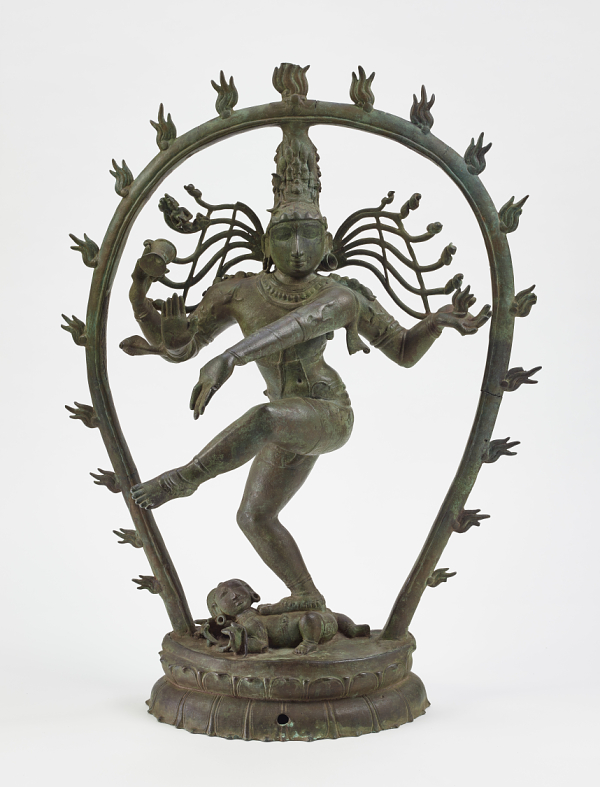
UPDATE 1/31/17: The Freer and Sackler’s head of collections management Elizabeth Duly reached out to say the museum has posted provenance details for the four objects on its Provenance Research page. We’re grateful for the museum’s openness.
The ownership history for the Chola bronze has several red flags. It includes an invoice stating that Doris Wiener bought the object from Rajrama Art Galleries in London in March 1973, six months after India passed its national patrimony law in September 1972.
Wiener claimed in a 1995 letter to then curator Vidya Dehejia that she had actually purchased the bronze months earlier and that it was seen in 1973 by Indian art authority Pratapaditya Pal. It’s unclear what motivated the letter. The story suggests that Wiener held the valuable bronze for 29 years – without publication or sale – before selling it to the Smithsonian in 2002.
We asked Vijay Kumar, an expert on South Indian art and smuggling networks who has consulted for U.S. law enforcement, to review the museum’s posting. “The given paperwork is straightaway problematic since the bronze has no provenance pre 1972 and no information on how it reached London pre 1972,” Kumar wrote. As for the 1995 letter, “There is no apparent reason for this explanation but an attempt to push the objects acquisition back by a year.”
Observing the patina, Kumar noted the condition of the bronze – especially the holes in the reverse and on the base pedestal – suggest it may have come from a buried hoard rather than an active temple.
“India should stake its claim for this bronze purely on the basis of no documented provenance pre 1973 and also take the official statements of the celebrated scholars in this case,” Kumar concluded.
Given the Wieners have been accused of fabricating ownership histories for decades, we agree it would be wise to further investigate these claims.
Next steps: As a federal agency, the Smithsonian museums are subject to Freedom of Information Requests. We should request all documents related to the acquisition of these objects.
Boston Museum of Fine Art
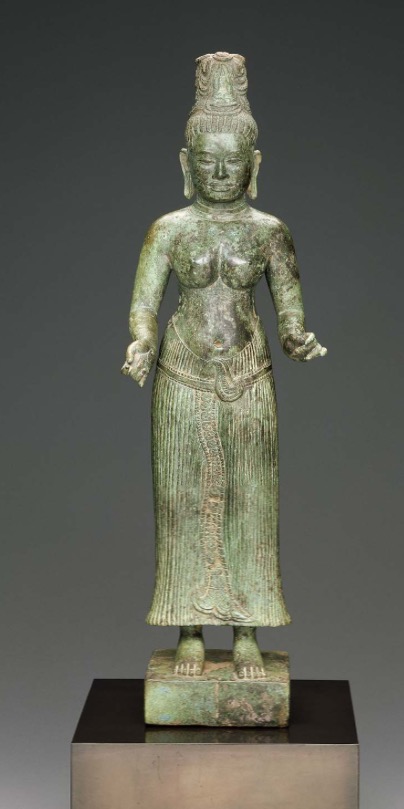
Female Khmer Deity
Victoria Reed, the curator of provenance at the Boston MFA, reached out pro-actively to share five objects the MFA acquired from Doris Wiener. They are:
Recumbent Bull (1988.434). 11th Century sandstone sculpture from Cambodia. Sold by Doris Wiener, Inc., New York, to the MFA. on October 26, 1988. No known provenance. No photo available.
Female Khmer Deity (1988.484). Doris Wiener apparently told museum the sculpture had been discovered near Wat Phu, Champasak Province, Laos and was first offered to a “Bangkok art collector” in early 1980s. Wiener sold it to the MFA on December 21, 1988.
Next step: Who is the “Bangkok art collector?” Might it be Douglas Latchford? Are there archival photos of objects at War Phu?
Shiva as Lord of Dance (1992.12) The sandstone sculpture from Central-eastern Madhya Pradesh was acquired by Doris Wiener in 1991. She sold it to the MFA on February 26, 1992. The museum has no other provenance.
Next step: Stylistically, what sites in central-eastern Madhya Pradesh could this sculpture could be associated with? Were those sites documented during colonial times?

Krishna Celebrates Holi (2002.901) Watercolor dating to 1750 – 60. Doris Wiener claimed to acquire the painting in 1972 and sold it to Paul F. Walter, New York; The painting was sold on November 14, 2002 at Sotheby’s, New York, lot 29, to the MFA.
Tibetan Avalokiteshvara (2003.339) According to a July 29, 2003 signed statement from art dealer Leonidas (Aleko) Goulandris, his gallery Arjuna Arts, Ltd. acquired the sculpture at Spink and Son, London, in 1967 and sold it to Doris Wiener in 2003. That same year, on September 17, Wiener sold it to the MFA.
Next step: Need someone to contact Goulandris to confirm the story and learn whether there is additional information about the sculpture’s origins prior to Spink and Son.
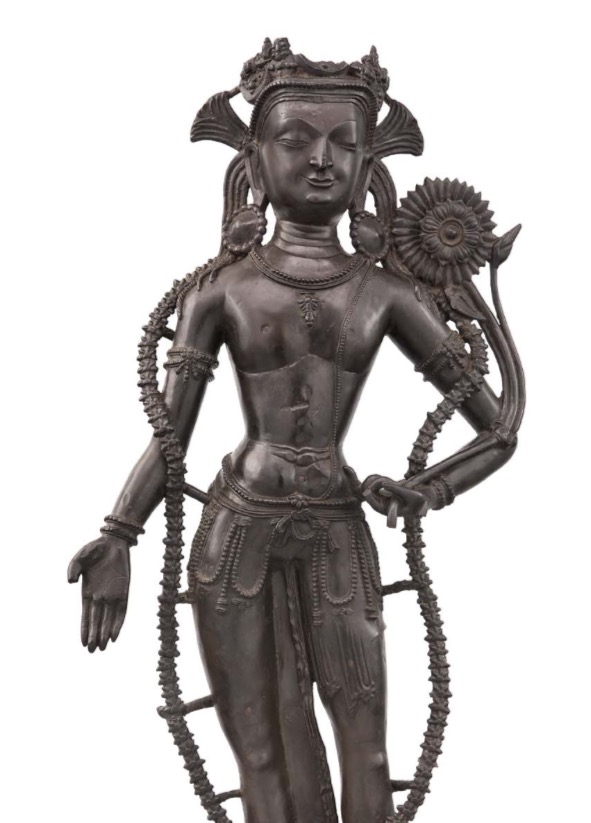
Avalokiteshvara
Art Gallery of New South Wales
Reader Judith Gibson pointed us to this 10th century Durga Slaying the Buffalo at the Art Gallery New South Wales (163.1999). The Australian museum, currently run by former Getty director Michael Brand, says it is investigating the origins of the sculpture, which was acquired from Nancy Wiener, who claimed to have it since 1999. The Australian has reported that Wiener sold it to the museum in 1999 for $95,000 without any proof of prior ownership. Wiener did not respond to the newspapers inquiries.
Next step: Inquire with the museum what steps it is taking to investigate the Durga.

Durga Slaying the Buffalo
Musee Guimet
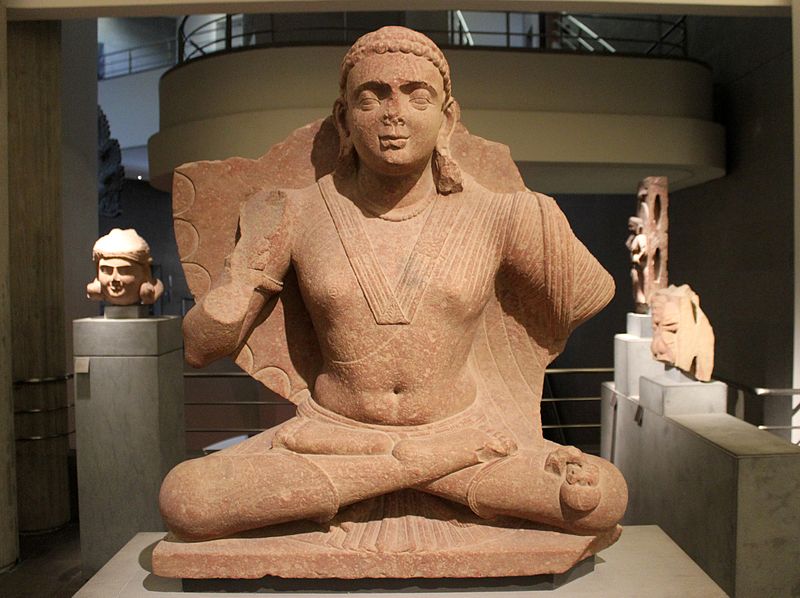 A confidential source pointed us to this Kushan Buddha at the Musee Guimet in Paris. The source believes Doris Wiener may have sold the sculpture, which is strikingly similar to Kushan Buddhas her daughter Nancy sold with false provenance to the National Gallery of Australia and Singapore’s Asian Civilizations Museum. As the criminal complaint detailed, these Seated Buddhas were allegedly stolen by the notorious convicted idol thief Vaman Ghiya.
A confidential source pointed us to this Kushan Buddha at the Musee Guimet in Paris. The source believes Doris Wiener may have sold the sculpture, which is strikingly similar to Kushan Buddhas her daughter Nancy sold with false provenance to the National Gallery of Australia and Singapore’s Asian Civilizations Museum. As the criminal complaint detailed, these Seated Buddhas were allegedly stolen by the notorious convicted idol thief Vaman Ghiya.
Next steps: Someone, preferably a French speaker, needs to contact the Guimet and politely inquire about the Guimet Buddha’s provenance. We should also ask for details on any other objects acquired from the Wieners.
ADDITIONAL LEADS
Here are some more leads to follow…
Museums
On her website, Nancy Wiener boasts of selling Asian art to museums around the world, including:
Metropolitan Museum of Art
Asia Society
The Los Angeles County Museum
The Art Institute of Chicago
The Nelson-Atkins Museum
The Asian Civilizations Museum in Singapore
Doris Wiener, who started dealing Asian art in the 1960s, is said to have sold objects to:
The Metropolitan Museum of Art
The Cleveland Museum of Art
The Norton Simon Museum
Asia Society
The Brooklyn Museum
This is obviously an incomplete list, so other museums with Asian art collections should also be searched or contacted. Don’t forget about University museums and collections.
As a starting point, try the museum’s online collection records, which can often be searched by ownership history. For example, the Metropolitan Museum of Art’s online collection shows 10 objects tied to Doris Wiener and 6 objects associated with Nancy Wiener. (We’ll contact the Met about those and post their response.)
For museums that don’t have complete provenance information online, which is most, please contact the museum and politely request a complete list of objects from the Wieners, along with all available provenance information for those objects. You may have to be persistent – this is information should be readily available to the public, but many museums are reluctant to release it. It may be helpful to note the antiquities policy of the Association of Art Museum Directors, which states:
AAMD is committed to the exercise of due diligence in the acquisition process, in particular in the research of proposed acquisitions, transparency in the policy applicable to acquisitions generally, and full and prompt disclosure following acquisition.
Museums that seek to be transparent and proactive should post all of their Wiener objects – with a complete ownership history – on their Provenance pages, as the National Gallery of Australia did (belatedly) in response to the Kapoor investigation. This is a clear signal of an institution’s good faith.
Auction Houses
Most major auction houses have online searchable sales archives that include some (but sadly not all) provenance information. Look for any objects that passed through the Nancy or Doris Wiener.
Once you find them, we’ll have to track down where they are today. Some creative Google searching can often work, as can reverse image searches on Google images or TinEye.
There’s also the Doris Wiener Collection. When Doris Wiener died in 2011, Christie’s sold a collection of 380 her objects. The criminal complaint against Nancy Wiener describes how many of those objects came through Asian smuggling networks.
Where are they today? Some were likely acquired by museums, while others were probably purchased by private collectors. Unless Christie’s releases this information, some sleuthing (or tipsters) will be required to track them down.
Like museums, auction houses who have done business with the Wieners should be proactive and transparent by posting complete information on objects they’ve sold tied to the Wieners. This will send a clear signal to the public that they’re not interested in protecting art traffickers.
Private Collectors
Doris Wiener is said to have sold antiquities to leading collectors, including John D. Rockefeller III, Igor Stravinsky and Jacqueline Kennedy. Nancy Wiener also sold to prominent private collectors.
What came of those collections? Where are those objects today? Private collections are difficult to search unless they’ve been published in a catalog or loaned to a museum or gallery show.
Some private collectors may want to come forward in good faith, and we should encourage them. If you own an object sold by Nancy or Doris Wiener – or know someone who does – email me here and share what you can. We may be help to help you assess its origins.
Dealer Catalogs
Many galleries publish sales catalogs of their inventory. Did Doris or Nancy Wiener? Can we track them down?
The Nancy Wiener Gallery’s website has posted images of objects she was selling over the years. The Internet Archive can be used to search it back to 2011: http://web.archive.org/web/*/http://www.nancywiener.com
Happy hunting!
Posted in News
Tagged Doris Wiener, Doris Wiener Gallery, India Pride Project, Nancy Wiener, Nancy Wiener Gallery
UPDATED > Manhattan Dealer Nancy Wiener Arrested: Criminal Complaint Alleges Sweeping Conspiracy to Sell Stolen Asian Art Through Major Auction Houses
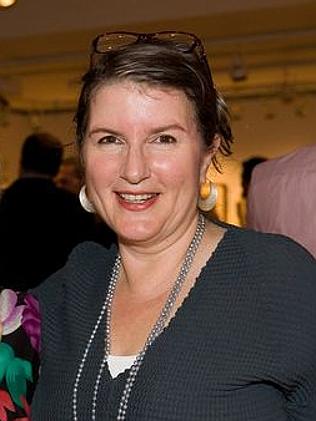 Antiquities dealer Nancy Wiener was arrested Wednesday morning in Manhattan and charged with conspiring with international smuggling networks to buy, smuggle, launder and sell millions of dollars worth of stolen Asian art thru leading auction houses.
Antiquities dealer Nancy Wiener was arrested Wednesday morning in Manhattan and charged with conspiring with international smuggling networks to buy, smuggle, launder and sell millions of dollars worth of stolen Asian art thru leading auction houses.
Wiener is a second generation dealer who runs one of the country’s most prestigious Asian art galleries on Manhattan’s Upper East Side. For nearly three decades, the Nancy Wiener Gallery has sold Asian art to private collectors and museums, including the Metropolitan Museum of Art, Asia Society, the Los Angeles County Museum, the Art Institute of Chicago, the Nelson-Atkins Museum, the National Gallery of Australia and the Asian Civilizations Museum in Singapore, according to her website.
The criminal complaint filed after her arrest on Wednesday alleges Wiener was part of a sweeping conspiracy to funnel stolen artifacts into the art market. For decades, the complaint alleges, Wiener has bought stolen and looted antiquities from thieves and smugglers across Asia; sent them to restorers to erase evidence of their theft; and then laundered them through Sotheby’s and Christie’s auction houses, using straw buyers to create false ownership histories and artificially set market prices.
The 12-page complaint, signed by ICE Special Agent Brenton Easter, cites “tens of thousands of pages of emails, documents and photographs” recovered during more than 50 search warrants carried out since 2007. Easter has been the lead investigator on Operation Hidden Idol (the Subhash Kapoor case), Operation Mummy’s Curse and most of the other prominent federal investigations of the illicit antiquities trade in recent years. The prosecutor on the case, Manhattan Assistant DA Matthew Bogdanos, also has a long track record disrupting antiquities smuggling networks and is the author of the book Thieves of Baghdad.
Wiener’s attorney, Georges G. Lederman, told the New York Times his client had surrendered voluntarily. “We are examining the charges and will respond at the appropriate time,” Lederman said.
I’ve asked Sotheby’s and Christie’s for comment on the allegations. I’ll post their responses here when I receive them.
The Seated Buddhas
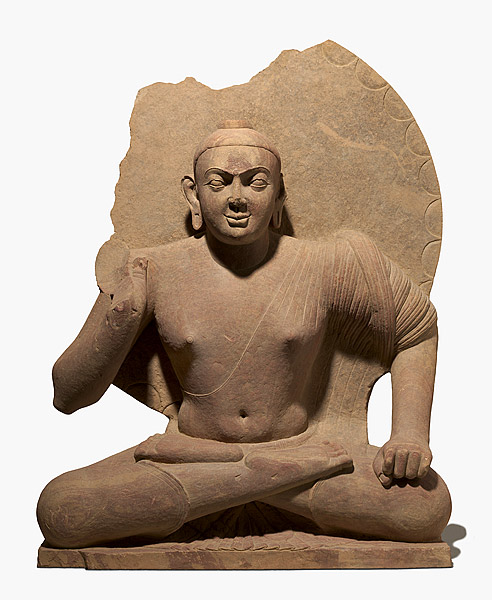
The Seated Buddha in Australia
Wiener’s alleged ties to the black market first came to light in 2014 when Michaela Boland and I reported in The Australian newspaper that the dealer had provided a false ownership history when she sold a $1.08 million Seated Buddha to the National Gallery of Australia. As I detailed later, the story started in 2012 when a source tipped me off that Wiener had bought the Australian Buddha – and a matching one that she sold to the Singapore’s Asian Civilizations Museum – from an Indian antiquities trafficker.
Australian authorities conducted their own investigation and reached the same conclusion. They returned the Buddha to India earlier this year, and Wiener was forced to refund the purchase price.
Wednesday’s criminal complaint cites the two Seated Buddhas as evidence of Wiener’s criminal conduct and reveals important new details about their illicit origins.
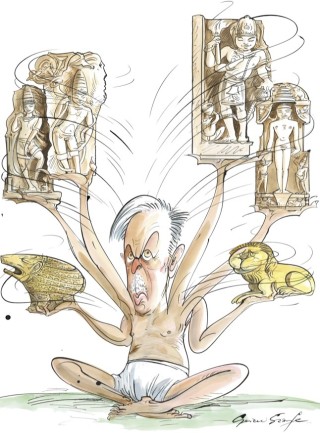 She sold the first to Singapore’s ACM without being asked to provide its ownership history, the complaint states. After I repeatedly asked the museum to release its records (to no avail), the museum appears to have contacted Wiener for additional information.
She sold the first to Singapore’s ACM without being asked to provide its ownership history, the complaint states. After I repeatedly asked the museum to release its records (to no avail), the museum appears to have contacted Wiener for additional information.
According to the complaint, Wiener gave the ACM an evolving series of stories about its previous owner: first she said it had been in a “European collection” for decades; then she said the owner’s father had acquired the piece in India. Finally, she named the former owner and said he had purchased it while stationed in Vietnam in the 1960s. That name, Ian Donaldson, is the same false story she provided to the National Gallery of Australia.
In fact, records seized during the investigation show that Wiener acquired them both from none other than Vaman Ghiya, the notorious Indian idol thief whose criminal case was profiled in the New Yorker in 2007.
Photos of the ACM Buddha seized during the investigation show it “wet as it lay on a dirty floor in front of a black backdrop” – presumably as it appeared shortly after being looted from India’s ancient city of Mathura, the second capital of the Kushan empire. The sculpture remains on display in the Singapore museum.

Auction House Due Diligence in the Spotlight
While they are not accused of criminal conduct, Sotheby’s and Christie’s play a prominent role in the alleged criminal conspiracy described in court records filed Wednesday. Several objects illustrate how the auction houses allowed Wiener to launder looted antiquities by accepting false ownership histories without question.
 When Wiener consigned a Cambodian sculpture of 11th century Shiva at a 2011 auction at Sotheby’s, the auction house noted that cracks in the sculpture “had been dressed up with plaint splatters to mask repairs” – a clear sign of looting, according to the complaint.
When Wiener consigned a Cambodian sculpture of 11th century Shiva at a 2011 auction at Sotheby’s, the auction house noted that cracks in the sculpture “had been dressed up with plaint splatters to mask repairs” – a clear sign of looting, according to the complaint.
Sotheby’s nevertheless accepted Wiener’s word that it had been out of Cambodia since 1968 and required no documentation from the dealer to support the claim. When selling Lot 29 at the March 24, 2011 sale, Sotheby’s described it as coming from a “Private English Collection, acquired 1960s.” “This exceptional figure exemplifies the highest achievements of the Baphuon School and is arguably amongst the best of its kind,” the catalog noted. It sold for $578,500.
In fact, there was no English collection, the complaint alleges. Seized emails show Wiener and a co-conspiritor (“an antiquities dealer based in London and Bangkok”) had acquired the sculpture “direct from a supplier, and not through a dealer” for half its market price. They sent it to London to be “cleaned, put together and mounted,” all evidence, the complaint alleges, that it had been recently looted.
I’ve asked Sotheby’s attorney (and former federal prosecutor) Jane Levine for a comment and will post it when I hear back.

The Doris Wiener Collection
Christie’s is also singled out in the complaint for the sale of nearly 400 objects – many of them allegedly looted or stolen – that had belonged to Nancy Wiener’s mother Doris, a prominent dealer in her own right who pioneered the Asian art market in the 1960s and 70s’s with sales to prominent collectors like John D. Rockefeller and Jacqueline Kennedy.
Doris continued to deal until her death in 2011, when Nancy inherited her mother’s collection and allegedly destroyed all records of the smugglers from whom they had been acquired. Wiener intially tried to consigned the collection for sale at Sotheby’s, but was turned away because she could not provide their ownership history. So Wiener turned to Christie’s, which according to the complaint only required evidence that the objects had been on the market since 2000 – a full 30 years later than the 1970 standard required by most museums and archaeologists.
Even that low bar was too high for Christie’s, which allegedly only asked Wiener for documentation on the top 25 of the sale’s 380 lots. Wiener told Christie’s 10 had come from Spink and Son, a defunct London auction house that has frequently been linked to looted antiquities. Several others had previously been sold at auction by Doris and re-acquired in “straw purchases” designed to create the impression of good provenance.
This dodgy track record for a fraction of the lots appeared to be enough for Christie’s, which auctioned all 380 lots on March 20, 2012 for a total of nearly $12.8 million dollars.
UPDATE: On December 28, Christie’s released a brief statement on the arrest of Nancy Wiener: “We are aware of these very serious allegations against the defendant and are monitoring the legal proceedings closely. We will withhold further comment until the appropriate time.” I’ve asked whether they will notify customers who purchased objects from the Doris Wiener sale and will post a response when I receive it.
Dozens of the objects sold in that sale have now been tied to smuggling networks reaching from Afghanistan and Pakistan to India, Cambodia and Thailand. We’re report details of those networks soon.
A copy of the criminal complaint can be read here:
Posted in News
Tagged Brent Easter, Christies, Matthew Bogdanos, Nancy Wiener, Nancy Wiener Gallery, National Gallery of Australia, Sotheby's
UPDATED > Inside the ISIS Looting Operation: U.S. Lawsuit Reveals Terror Group’s Brutal Bureaucracy of Plunder
A civil lawsuit filed today by the U.S. government sheds startling new light on the brutality of the Syrian looting operations of the Islamic State.
The lawsuit seeks the forfeiture of four looted objects – a gold ring, two gold coins and a stone relief – that were allegedly sold by the Islamic state to fund terrorism. Photographs of the objects were recovered during the May 2015 special forces raid on Abu Sayyaf, an ISIS leader in Deir Ezzor, Syria charged with managing the region’s Ministry of Natural Resources, which included looting operations.
The records show Sayyaf, who was killed in the raid, was part of a well-organized looting bureaucracy that ISIS used to generate revenue, as shown in this organization chart that was found among the documents recovered from his house:
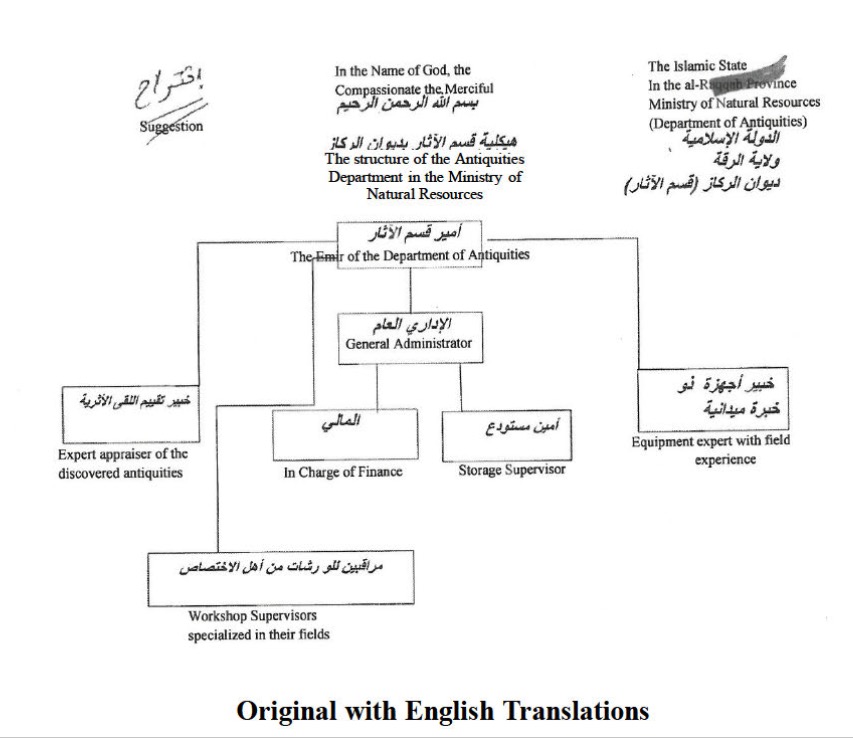
As a regional chief, Abu Sayyaf issued looting permits and charged looters a Khums tax, 20% of the value their finds. He also had the ability to arrest individuals excavating archeological objects without authorization.
Much of the evidence from the Sayyaf raid cited in the case was first released publicly in November 2015 – and greeted with some skepticism by experts on the illicit trade, including myself. In particular, the raid fueled the heated debate about how much revenue ISIS actually generates from looting. The seized documents showed just $211,000 in revenue generated by the looting tax, suggesting the millions in looting revenue cited in some news accounts could be far off the mark.
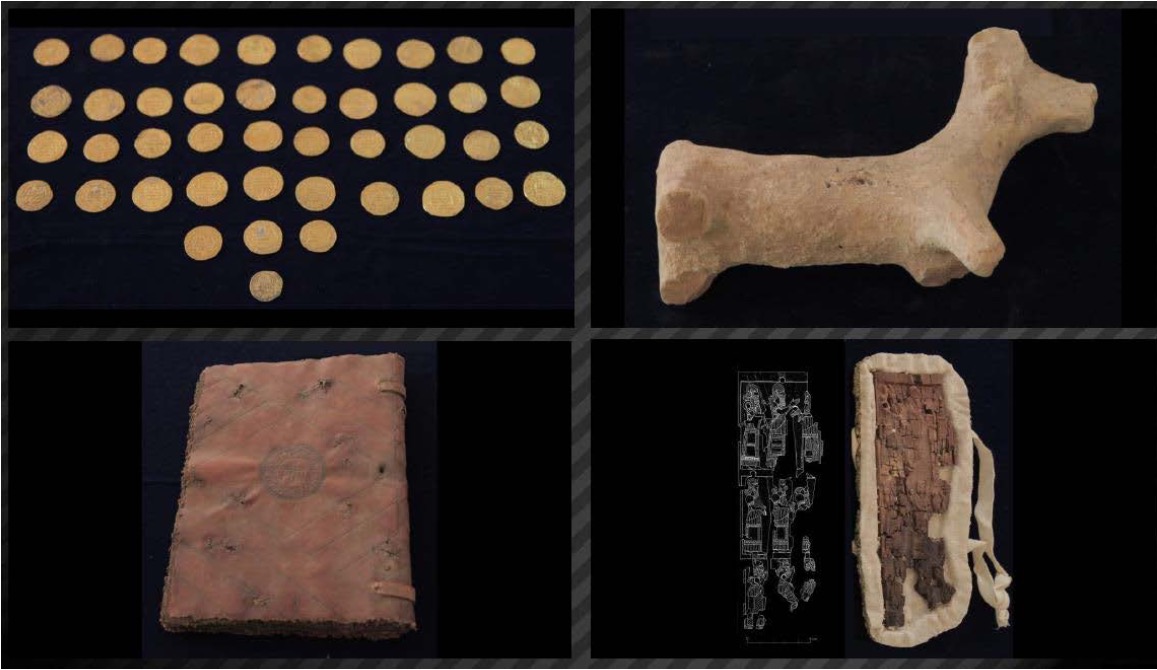
Objects seized from Abu Sayyaf during a special forces raid in May 2015
But Thursday’s filing includes new records from the Abu Sayyaf raid that have not previously been released. Among other things, they include a harrowing account from looters who were extorted by ISIS – Abu Sayyaf ordered their child kidnapped when they refused to pay an low-ball price for a cache of gold and relics they had discovered.
The four objects being sought were shown in electronic images seized from Abu Sayyaf during the raid and were sold directly by him, according to the complaint. As detailed below, the FBI’s subsequent investigation was able to find additional information about at least one of the objects as it passed through the illicit trade.
Taken together, the newly released records give us a detailed but narrow window into ISIS’ efforts to profit off the international market in ancient art.
Like the evidence released before it, these new records should be considered critically – particularly at a time when a U.S. military intervention in Syria appears more likely. It is worth asking why the U.S. government has filed the complaint now, more than a year and a half after the evidence was gathered; why the government seeks the forfeiture of objects whose current location is unknown; and why this information is being released publicly, when it virtually guarantees the objects will not surface on the art market.
UPDATE 12/16/16: On Friday, I spoke with Arvind Lal and Zia Faruqui in the US Attorneys Office of the District of Colombia. Lal is the chief of the Asset Forfeiture and Money Laundering Section and Faruqui is the Assistant U.S. Attorney from that section who did much of the work on the complaint. Here is a summary of their answers to the questions above.
Where are the objects? Lal and Zia declined to say whether they knew where the objects were, citing the on-going investigation of the Abu Sayyaf material. But they said the complaint makes clear they are not currently in the United States.
Why file the complaint now? Lal said that the time between the May 2015 raid and the forfeiture complaint was necessary to conduct a thorough investigation of the records seized from Abu Sayyaf, consult with experts on the objects depicted in those records, coordinate with other federal agencies (FBI, State, Treasury and “other government agencies”) and compile the complaint. “We feel like we’ve done our homework with respect to these four items,” Lal said, suggesting that additional items may be added to the complaint in the future.
What is the strategy in filing a complaint against missing assets? “By filing this action, we hope we’ve dropped the market value of these four items to zero, along with anything else that may have passed through the hands of ISIS. Hopefully the market is now on notice that if something goes through the hands of ISIS, that item is subject to being seized.”
The most revealing exchange, in my view, was Lal’s response to my question about the strategy. Filing the complaint makes it nearly certain that these will never surface, I pointed out. Why not monitor the art market to see where they pop up and seize them at that time?
“I have a case load from narcotics to fraud to national security cases,” Lal said. “I don’t have a staff available to monitor the international art market. When I find out about a crime, I feel obligated to do what I can.”
Where there political motives driving the decision to file? “I’m a prosecutor,” Lal said, “I don’t give an damn about the politics of this.”
The Looted Objects
The four objects described in the forfeiture complaint range in estimated value from $50,000 to a few thousand dollars, and date from various periods and civilizations found in Syria. Below I’ve posted below the highest resolution images available from the U.S. Attorney’s office, along with details described in the federal complaint.
- A gold ring, photographed in November 2014, may depict the Greek goddess of fortune, Tyche and dates to approximately 330 BC – 400 AD. It is believed to come from Deir Ezzor, Syria. Investigators found an earlier picture of the same ring showing soil embedded in the carving, suggesting it had been recently excavated and was later “enhanced” for international sale, the complaint alleges. The ring was part of a set that sold previously (presumably in Syria) for $260,000.
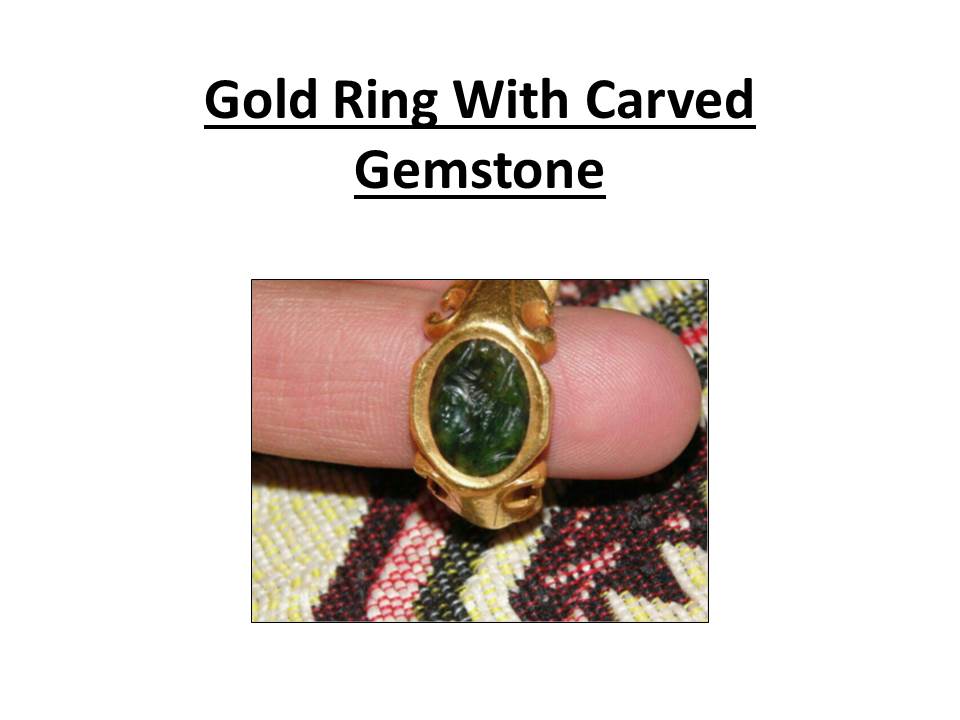
2. Another photograph recovered from Abu Sayyaf shows a Roman gold aureus dated to 138 – 161 A.D. showing Antoninus Pius on one side and the goddess Liberalitas on the reverse. It was photographed in November 2014 and may have been looted from one of the numerous Roman or Greek sites in Syria, the complaint states.
 3. A second gold coin depicted on images found on Abu Sayyaf’s hard drive shows Emperor Hadrian Augustus Caesar saying from 125 – 128 AD, the complaint states.
3. A second gold coin depicted on images found on Abu Sayyaf’s hard drive shows Emperor Hadrian Augustus Caesar saying from 125 – 128 AD, the complaint states.
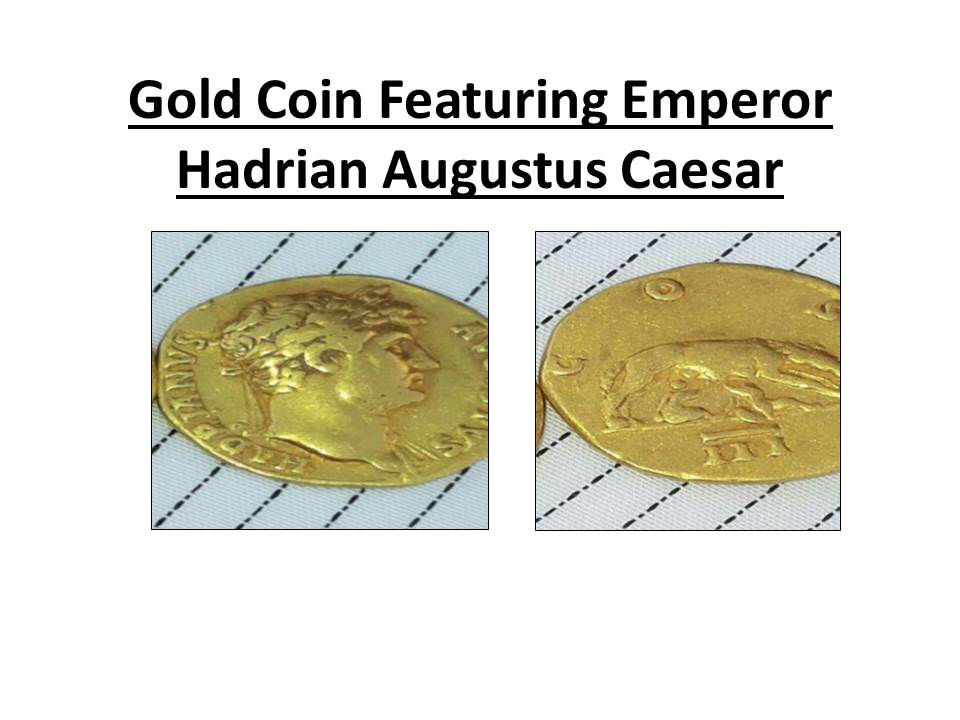 4. The fourth object, depicted in an image found on Abu Sayyaf’s WhatsApp account on his cellphone and created in August 2014, shows a stone relief with cuneiform writing. The inscription, which is legible from the photographs, is an Assyrian dedication to King Shalmaneser III (859 – 824 BC). The object is believed to be from the archaeological site of Tell Ajaja in northern Syria. The relief has an estimated value of $30,000 – $50,000, the complaint states.
4. The fourth object, depicted in an image found on Abu Sayyaf’s WhatsApp account on his cellphone and created in August 2014, shows a stone relief with cuneiform writing. The inscription, which is legible from the photographs, is an Assyrian dedication to King Shalmaneser III (859 – 824 BC). The object is believed to be from the archaeological site of Tell Ajaja in northern Syria. The relief has an estimated value of $30,000 – $50,000, the complaint states.
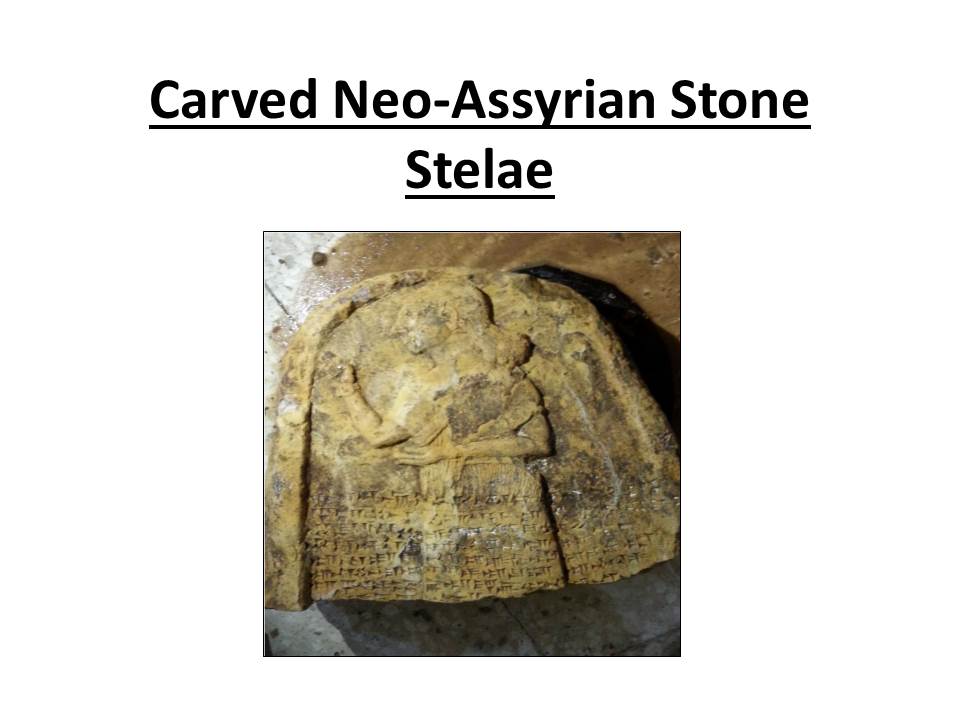
Looters Testify about Extortion, Kidnapping under ISIS Antiquities Authorities
ISIS’ taxation system for looted antiquities has an obvious flaw: the value of the finds are difficult to know before they are sold on the international market. As a result, the basis for the Khums tax imposed by Abu Sayyaf’s department was often quite arbitrary. Not surprisingly, this led to conflicts between looters and their ISIS tax collectors.
Remarkably, one of these disputes is detailed in the newly released documents. The records show that ISIS authorities concluded that Abu Sayyaf had used his position of power to extort looters and kidnap one of their children when they refused to pay ISIS levies. 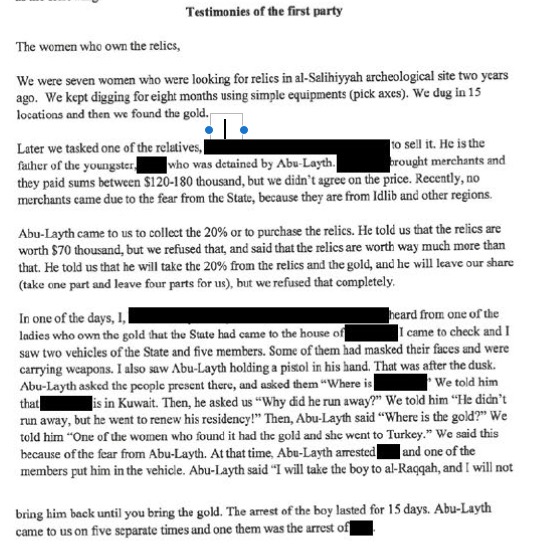
Remarkably, the documents seized from Sayyaf include direct testimony from some of his victims, who filed a complaint with the Islamic State’s General Supervising Committee. A redacted translation of the testimony, as well as images of the original document, is included in the forfeiture complaint. What follows is an account based upon these records:
In 2013, seven women from the village of al-Duwayr spent eight months digging with pick axes in the al-Salihiyyah archaeological site outside Damascus. (There are two locations named al-Salihiyyah in Syria, but as Paul Barford notes in the comments below, given the context this likely refers to the site outside Deir ez-Zor, where Abu Sayyaf was based.) During the illicit dig they found a cache of gold and other ancient relics.
The women asked a male relative, whose name is redacted, to sell the finds, but he could not reach an agreed upon price with local merchants, who offered up to $180,000. (It is not clear what currency is being discussed, but else where the records note many deals were transacted in U.S. dollars.)
Abu Sayyaf’s deputy, Abu Layth, learned of the find and came to collect the ISIS Khums tax, 20% of the discovery’s value. He put the value of their discovery at just $70,000 and offered to buy it all. When the looters refused the low ball price, Abu Layth attempted to take one-fifth of the find in lieu of the tax. That too was refused by the women.
Days later, Layth and five members of the Islamic State arrived at the house of one of the looters in masks and toting guns. Abu Layth, brandishing a pistol, demanded to know where the gold was. The women said it had already been taken to Turkey.
At that point one of the ISIS men grabbed a 15-year-old boy. Abu Layth stated, “I will take the boy to al-Raqqah and I will not bring him back until you bring the gold.”
The boy testified about his abduction, saying he was blindfolded, beaten in the back of the vehicle, threatened with a pistol to his head and then held for 15-days in al-Raqqah.
In his own testimony, Abu Layth acknowledged he had no experience with antiquities. He had worked for the ministry of natural resources for nine months, and had previously sold clothes and food.
Abu Layth testified that he was given $130,000 to purchase the relics but offered only $70,000 to the looters. Merchants in Turkey, who he communicated with “via mediators,” said the finds could be worth as much as $200,000. He said he had arrested the boy at the order of his boss, Abu Sayyaf.
Having heard the testimony, the Islamic State’s General Supervising Committee issued its ruling: Abu Sayyaf should fire Abu Layth, hire own responsible men, and apologize to the family for arresting the boy without justification.
Below are links to the federal complaint and attachments containing the documents it references. I welcome your additional thoughts in the comments section.
Federal complaint: https://www.documentcloud.org/documents/3239356-Forfeiture-Complaint-Stamped-Copy-12-15-16.html
Attachments to the complaint: https://www.documentcloud.org/documents/3239355-Attachments-to-Forfeiture-Complaint.html
Posted in News
Tagged Abu Sayyaf, antiquities, Deir Ezzor, FBI, ISIS, Islamic State, Khums tax, looting, Syria, US Attorney's office
The End of the Beginning: NGA Returns Kushan Buddha and Two Kapoor Objects
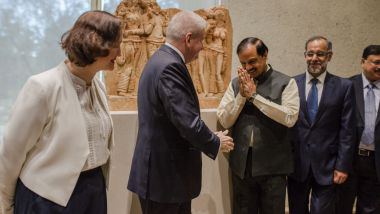
On Monday, the National Gallery of Australia returned three more antiquities to India in light of evidence – much of it first made public here – that they had been stolen from temples or archaeological sites, smuggled out of India and sold with false ownership histories by dealers now under criminal investigation.
In a ceremony in the Canberra museum’s Asian Gallery, the Australian Arts Minister Mitch Fifield handed over to his Indian counterpart Mahesh Sharma two sculptures purchased from the disgraced Manhattan antiquities dealer Subhash Kapoor, who is currently standing trial in Chennai, India for his role as the alleged mastermind of an international smuggling ring.
A third sculpture, a Kushan-era sculpture of the Seated Buddha purchased from Manhattan antiquities dealer Nancy Wiener and once a centerpiece of the Australian collection, is being quietly returned out of the public eye. We first revealed the sculpture’s false ownership history in February 2015 and wrote about it in The Australian with arts reporter Michaela Boland.
The three sculptures join the museum’s Dancing Shiva, an Ardhanarishvara from the Art Gallery of New South Wales and other objects returned in recent years, the results of a looting controversy that has shaken Australia’s museums and raised far-reaching questions about their collecting practices. Some 280 additional antiquities at the NGA alone have been identified as having a clouded ownership history by an unprecedented provenance review that is on-going.
The Australian returns underscore the growing risks faced by museums and collectors who purchased Asian antiquities in recent decades from what they believed to be respectable dealers and auction houses. As we’ve chronicled here since 2012, on-going criminal investigations by authorities in the United States, India, Pakistan, Cambodia, Thailand and beyond have slowly unraveled the transnational smuggling networks that supplied those dealers.
Sources hint that the sweeping consequences of those investigations will soon become far clearer. Monday’s Australian returns, therefore, are best understood as the end of the beginning phase of those investigations, not the end.
Kushan Buddha
 The Kushan sculpture of a Seated Buddha was likely returned out of the public eye on Monday because it no longer belongs to the museum. In March 2015, the museum announced that it had returned it for a refund to Nancy Wiener, the New York owner of the Wiener Gallery who sold the statue in 2007 for $1.08 million. Wiener, in turn, agreed to “donate” it to India.
The Kushan sculpture of a Seated Buddha was likely returned out of the public eye on Monday because it no longer belongs to the museum. In March 2015, the museum announced that it had returned it for a refund to Nancy Wiener, the New York owner of the Wiener Gallery who sold the statue in 2007 for $1.08 million. Wiener, in turn, agreed to “donate” it to India.
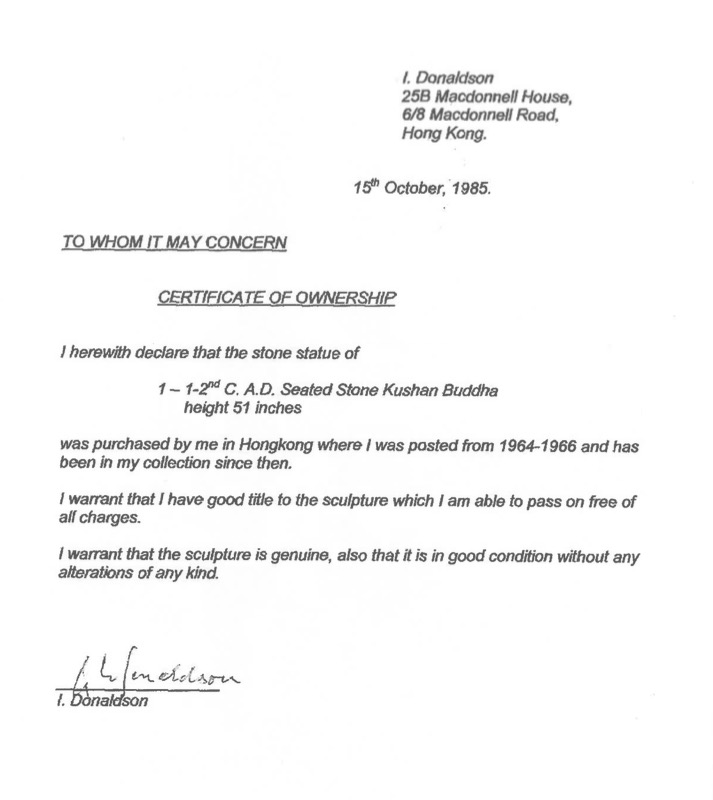
At the time of the sale, Wiener said the sculpture had belonged to an Englishman named Ian Donaldson, who claimed to have purchased it while posted in Hong Kong between 1964 and 1966. She provided the museum with a 1985 Certificate of Ownership signed by Donaldson. It was the only record of sculpture’s ownership history, but the museum did not attempt to contact Donaldson. Instead, the NGA obtained a search certificate from the Art Loss Register saying the sculpture was not in its database of stolen objects. As we’ve noted in the past, such declarations are largely useless for antiquities, yet that was the extent of the due diligence the museum conducted.
I first raised questions about the Buddha in 2012, after a source contacted me suggesting the statue’s ownership history had been falsified. The NGA eventually released documents supporting that claim and belatedly contacted the expert who had first authenticated the sculpture, Donald Stadtner. Stadtner raised further questions about the sculpture’s origins, claiming in an email to museum officials that British collector Douglas Latchford had boasted in a meeting that he had “found Nancy a provenance” for a related Kushan Buddha that Wiener sold to Singapore’s Asian Civilizations Museum. Through his attorneys, Latchford has denied ever meeting Stadtner.
The return of the NGA’s Seated Buddha will put increased pressure others to reveal the ownership history of similar objects. Singapore’s Asian Civilizations Museum has refused to disclose the provenance that Wiener provided for a very similar sculpture of a Seated Buddha.
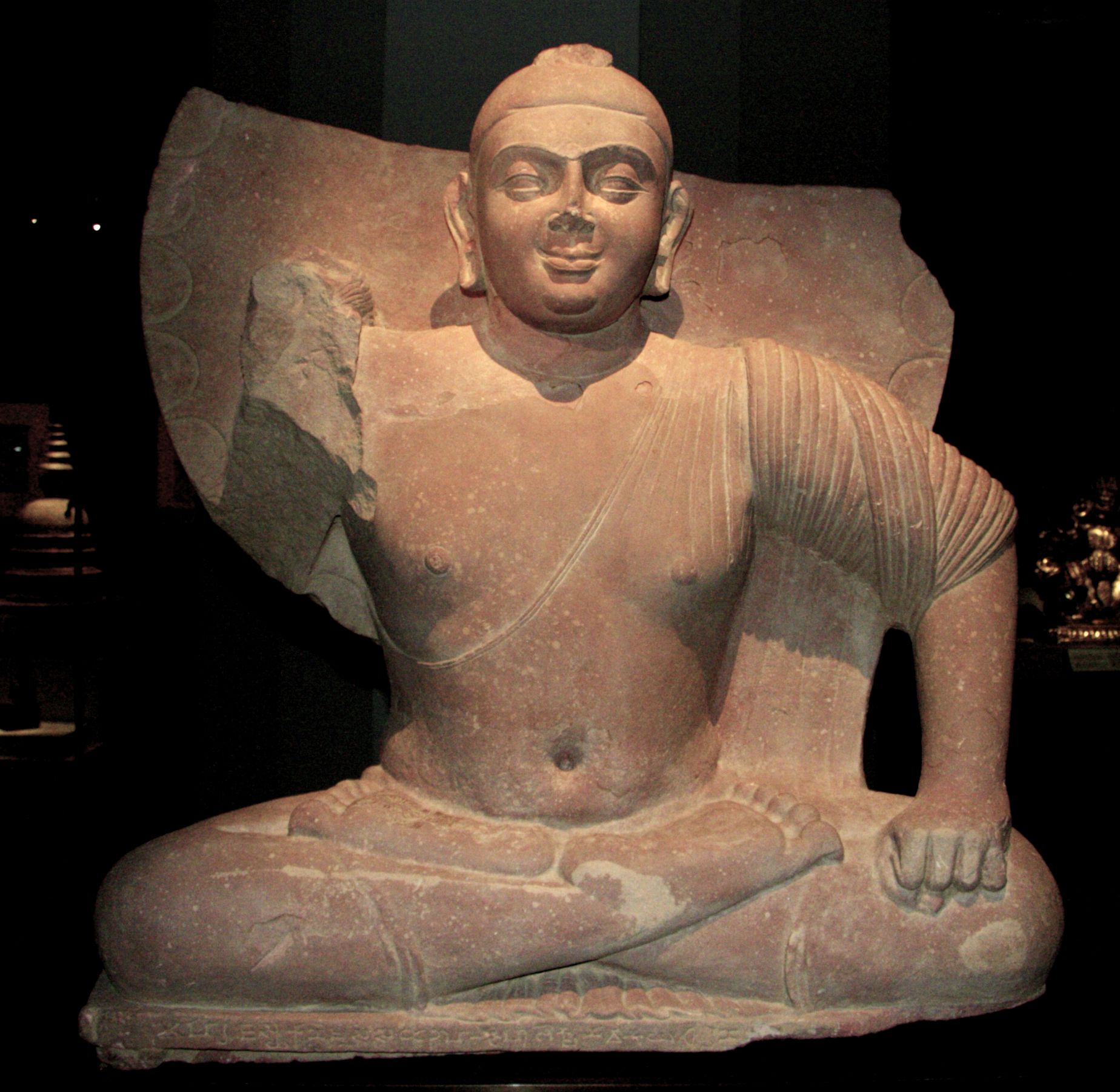
Wiener has displayed images of a third Kushan Buddha on her gallery’s website. The current location of that Buddha is not known. Wiener has not responded to repeated requests for comment in the past.
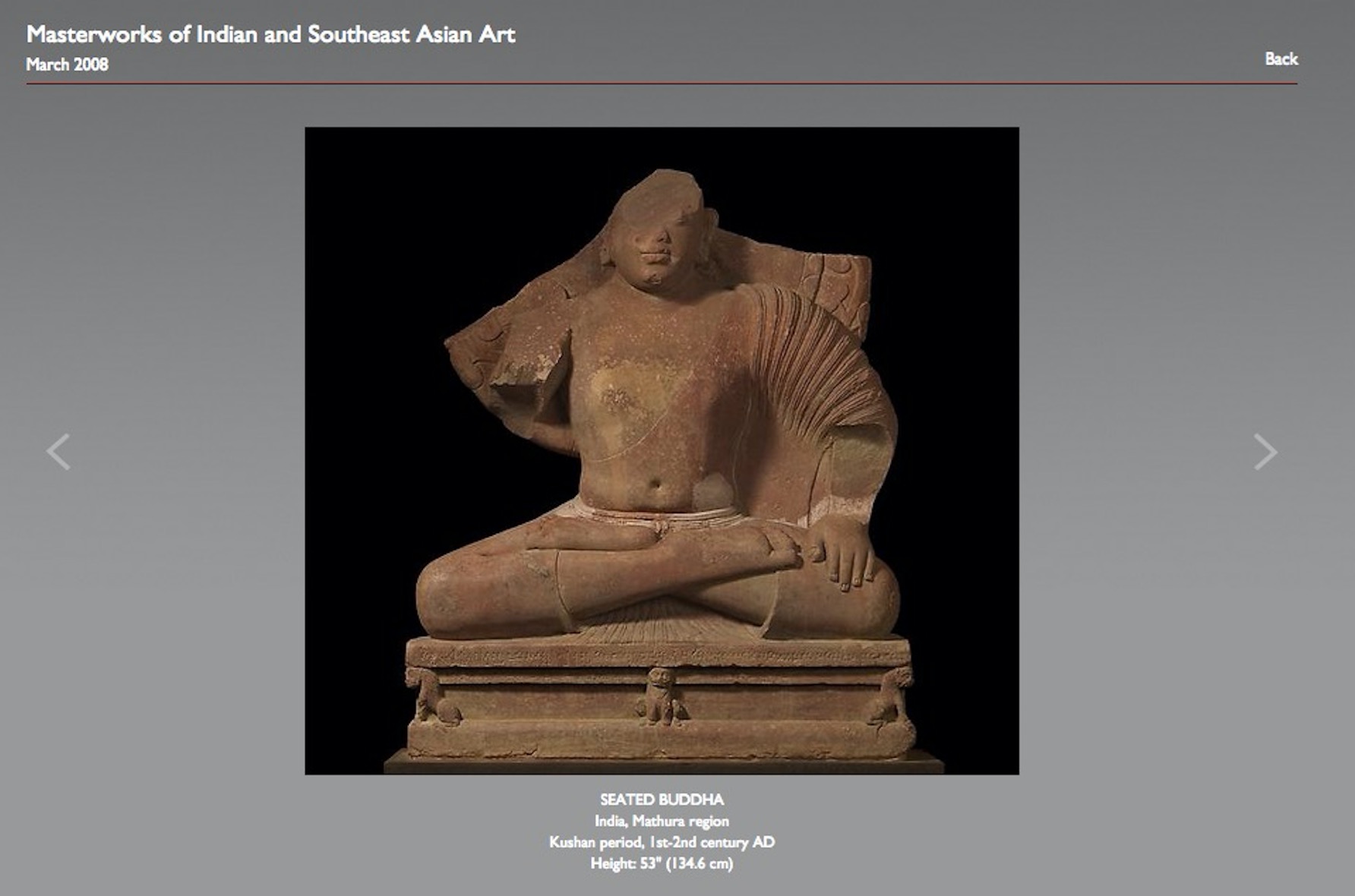
Another similar Buddha is on display at the Carlos Museum at Emory University. That Seated Buddha was acquired as a gift of the Nathan Rubin-Ida Ladd Family Foundation, which is known to have acquired objects from Kapoor.
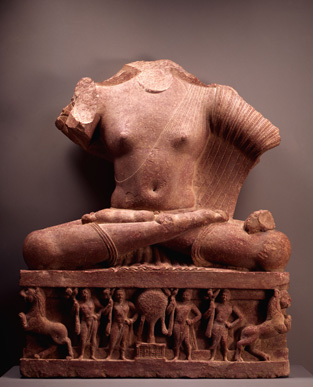
Kapoor Objects
The two other objects returned Monday are both from Subhash Kapoor and were linked to objects stolen from Indian temples by researcher Vijay Kumar of the Indian Pride Project.
In 2005, Kapoor sold both objects to the NGA for $1.5 million. One was an 1800-year-old limestone carving depicting a scene from the life of Buddha.
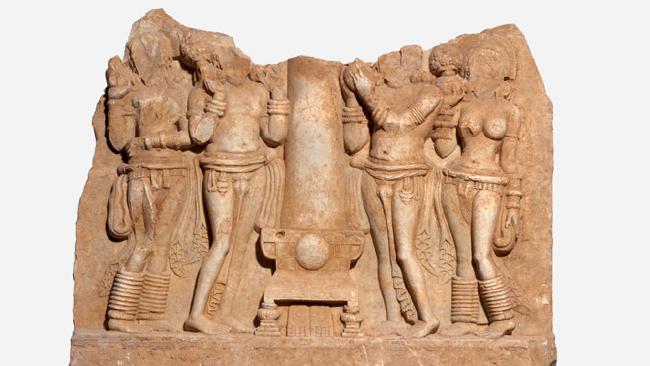
Kapoor told the museum the sculpture of the Buddha’s life had been in a private Japanese collection until 1999. But in July, we published this photo of the showing the unrestored sculpture as it appears in Kapoor’s archives, soon after it was stolen by thieves:
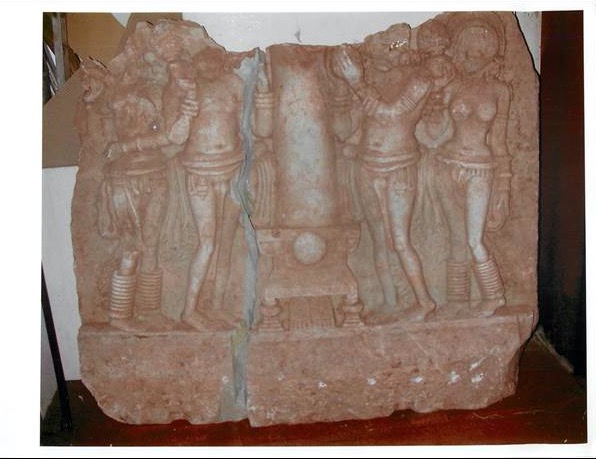
The second Kapoor object due to be returned in the ceremony Monday was a 1000-year-old stone goddess Pratyangira, or Lion Lady. Kapoor claimed the sculpture had been in the collection of his onetime girlfriend Selina Mohamed since 1990. But as we first reported in July 2016, photos and records found in Kapoor’s files show the Pratyangira was in Mumbai, India in 2002.
Kumar has linked the object to Vriddhachlam, the same temple that the Art Gallery of New South Wales Shiva was taken from.
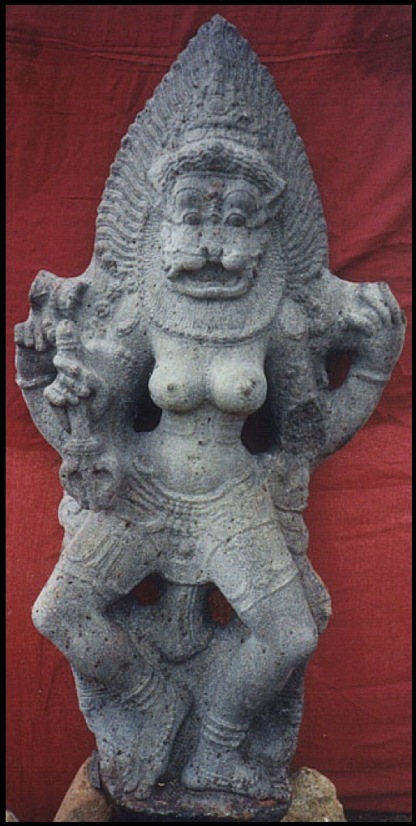
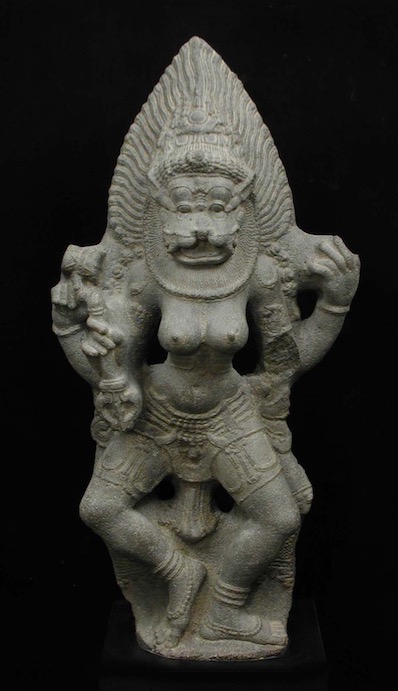
Investigators believe Kapoor obtained the two objects from a Chennai art dealer named Deena Dayalan, who has operated an art gallery there since 1965 and is suspected of being a major player in the theft and smuggling of antiquities from the region. Indian authorities raided Dayalan’s properties in July and seized substantial evidence that may have led to Monday’s returns.
The Missing Link: Subhash Kapoor’s Suppliers in India Are (Finally) Getting Rolled Up
Update September 2016: Indian media report that a temple thief who worked for Deena Dayalan has been accused of murdering a fellow thief after a dispute over 13 idols they took from a temple in 2005.
In a series of aggressive police raids over the past month, Indian authorities have disrupted a large network of alleged thieves and smugglers that for decades has plundered ancient temples from Chennai to Mumbai to supply the international art market.
The raids started on May 31st with the arrest of three men at a Chennai warehouse (or godown, in the Indian parlance). The men were employees of an 84-year old art dealer named Deena Dayalan, who has operated a Chennai art gallery since 1965. Indian and American authorities believe Dayalan has long been a major player in the theft and smuggling of antiquities from South India.
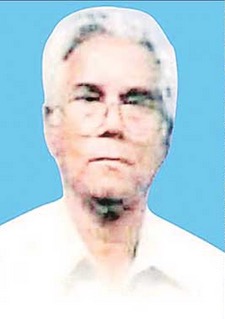
Deena Dayalan, via Indian Express
Dayalan disappeared after the raid, but turned himself in a few days later. He is said to have confessed during an interrogation and listed his associates and storage facilities across India. Subsequent raids on his properties uncovered hundreds of artifacts, including 49 bronzes, 71 stone carvings and 96 paintings and hundreds of smaller objects including ivory and wood carvings, lamps, figurines and ornamental pillars.
As reported by Frontline, The Hindu newspaper’s weekly magazine, policemen entering Dayalan’s house were stunned by the scope of his haul:
“It looked like a temple,” one investigator told Frontline. “Besides the idols and artefacts, there were pamphlets and books on temple idols and archtecture. The pillars of his house could be from some old temples. There were wooden sculptures and two elephant heads at the entrance,” said an officer.
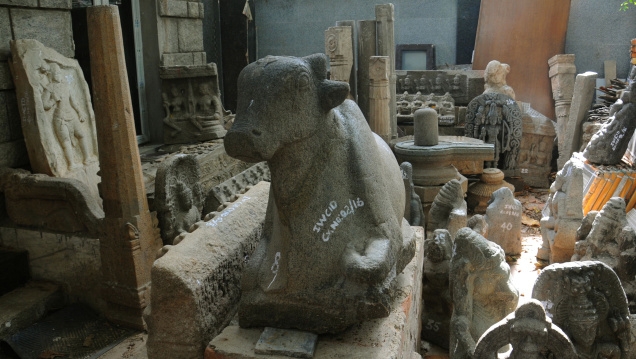
The raid was not Dayalan’s first run-in with the law. Frontline reported the dealer was accused of being behind the 2005 break-in at the ancient Sri Narum Poonathar Temple at Paluvoor village in Tirunelveli, where 13 bronze idols were stolen. After the theft, an accomplice was murdered in a dispute over efforts to extract gold from two-and-a-half-foot bronze Nataraja, which was sawn in half in the process. Dayalan was released on bail, and the case is on-going.
UPDATE 7/4/16: The Tamil Nadu Idol Wing has seized 200 objects from Lakshmi Narayanan, an associate of Dayalan. Authorities found 56 were metal idols, 103 stone idols, and 47 temple vahanas (decorative platforms used to carry the deity in processions), The Hindu reports. Narayanan was arrested and will face charges of idol theft.
 The police raids have now spread beyond Tamil Nadu are likely to continue in the coming weeks that authorities unravel the smuggling network and sort through voluminous evidence. Authorities have identified the courier service that Dayalan used to transport objects within India and seized his laptop, a desktop computer and storage drives. He allegedly labeled his stolen artifacts as modern handicrafts before they were smuggled out of India through Mumbai, where an unnamed “boss” in the illicit trade remains at large.
The police raids have now spread beyond Tamil Nadu are likely to continue in the coming weeks that authorities unravel the smuggling network and sort through voluminous evidence. Authorities have identified the courier service that Dayalan used to transport objects within India and seized his laptop, a desktop computer and storage drives. He allegedly labeled his stolen artifacts as modern handicrafts before they were smuggled out of India through Mumbai, where an unnamed “boss” in the illicit trade remains at large.
The investigation promises to give investigators what one Indian paper called “a glimpse of the man’s murky business with several smuggling cartels across the globe.” As The Hindu noted in an editorial, “The meticulously organised nature of this shadowy business hints at the deep and vast network of idol thieves who have plied their trade across not only Tamil Nadu but numerous other Indian States and even broader territories of South and South East Asia.”
The Kapoor Link
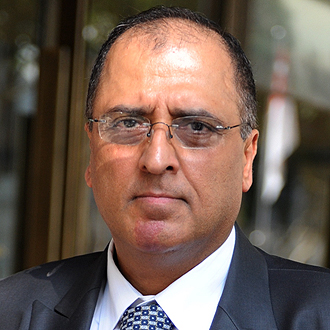 Investigators are still looking for links between Dayalan and one of his prominent American clients: Subhash Kapoor, the Manhattan antiquities dealer now standing trial in India for selling stolen antiquities to museums around the world. “We have not got clinching evidence to prove [his] link with the international idol smuggler Subhash Kapoor,” one investigator told the Times of India.
Investigators are still looking for links between Dayalan and one of his prominent American clients: Subhash Kapoor, the Manhattan antiquities dealer now standing trial in India for selling stolen antiquities to museums around the world. “We have not got clinching evidence to prove [his] link with the international idol smuggler Subhash Kapoor,” one investigator told the Times of India.
We can help: The following document links Dhayalan to Kapoor and hints at the extensive business relationship they are believed to have had.

The document records Dayalan’s 2007 request for a payment of USD $11,400 from Kapoor’s Nimbus Import & Export through Selva Export, one of the Chennai export companies they used to transport artifacts. It is still unclear whether that amount was paid, what object(s) were purchased for the sum, and where those objects are today.
 But authorities have already identified Dayalan as the source of one stolen Kapoor object that has already been returned to India: The Art Gallery of New South Wales‘ sculpture of Ardhanarishvara, whose origins we revealed in 2013.
But authorities have already identified Dayalan as the source of one stolen Kapoor object that has already been returned to India: The Art Gallery of New South Wales‘ sculpture of Ardhanarishvara, whose origins we revealed in 2013.
The AGNSW purchased the sculpture for $300,000 after Kapoor provided documents claiming it had left India in the 1970s. But Vijay Kumar of the India Pride Project identified images that showed the sculpture in situ at the Vriddhachalam temple at least four years after 1970. A subsequent police investigation concluded it had been stolen in 2002 by Dayalan and replaced by a knockoff that villagers continued to worship.
Dayalan is believed to have supplied Kapoor with a number of objects from South India.
As Michaela Boland reported Sunday in The Australian, Dayalan is believed to have supplied Kapoor with two other objects that landed in the National Gallery of Australia: an 1800-year-old limestone carving depicting a scene from the life of Buddha, and a 1000-year-old stone goddess Pratyangira, purchased together from Kapoor in 2005 for $1.5 million. 
Kapoor told the museum the sculpture of the Buddha’s life had been in a private Japanese collection until 1999. But this photo, found in Kapoor’s archives, shows the unrestored sculpture above soon after it was stolen by thieves:
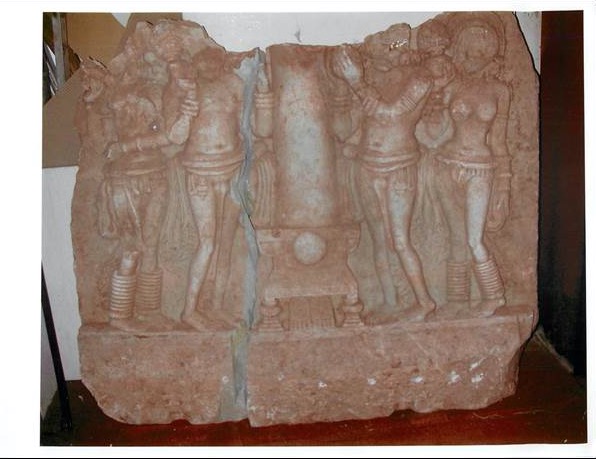
A similar tale emerges on the NGA’s Pratyangira. Kapoor claimed it had been in the collection of Selina Mohamed (his onetime girlfriend) since 1990. But photos and records found in Kapoor’s files show the Pratyangira was still in Mumbai, India in 2002.
Below at left we see the NGA’s Pratyangira as offered in a Kapoor catalog, and at right the same sculpture before it left India. Note the identical missing segments from the figure’s left elbow.
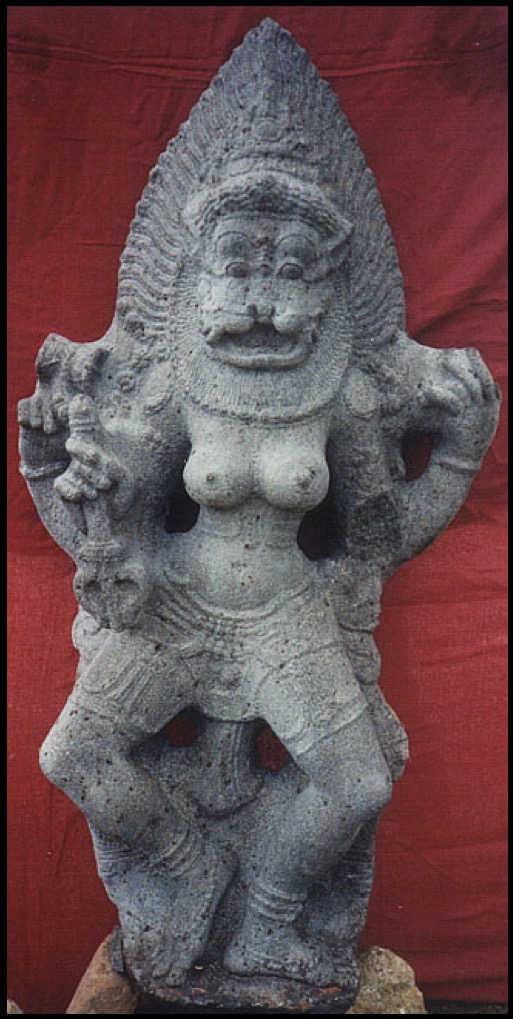

Amaravati Objects
Investigators believe Dayalan may have been behind looting of material from Amaravati, an important archeological site in Andhra Pradesh, where Dayalan grew up. Items seized from his warehouses include Amaravati architectural fragments.

Dayalan may well have been the source of Amaravati fragments that Kapoor sold to the Asian Civilizations Museum in Singapore.

As we wrote in 2014, Kapoor sold the ACM a 3rd Century limestone fragment from Amaravati in October 1997 for $22,500. His accompanying description suggests he had detailed knowledge of the find spot:
“Examples from the Amaravait stuppa are extremely rare to find,” he wrote. “This particular piece does not come from the stuppa proper, but from the outer rail copings that surrounded the stuppa. It is an exceptional example in both its size and in its illustrative qualities…The iconography of this fragment makes this a most interesting piece from the Amaravati area.”
Long Time Coming
The Indian raids are long overdue. Records show American authorities provided detailed evidence about Kapoor’s Indian suppliers as far back as 2014. India’s failure to act on those leads, despite repeated urging from American authorities and others, has been one of several troubling signs in the long delayed criminal trial of Kapoor.
As Kumar recounted in an article about the investigation by ICE U.S. Special Agent Brent Easter: “For too long the red tape of Indian Bureaucracy and the ill equipped custodians have sent him on wild goose chases – including multiple weeks in hot and sultry India, with promises of arrests of the bad guys. Frustrating, when he has done all the hard work and with irrefutable proof of the bad guys shipping documents, email exchanges and bank transfers to see the patchy attempts in delaying and letting the actual crooks off the hook.”
It is likely no coincidence that the Indian raids were launched just days before U.S. Attorney General Loretta Lynch announced the return of 200 looted antiquities to India during the state visit of Prime Minister Narendra Modi. The returns, many of which had been seized from Kapoor or his clients, may have been used as leverage with India to ensure Kapoor’s suppliers were nabbed. (On the right below is the Toledo Ganesh, which Kumar first revealed as looted in a 2013 post.)
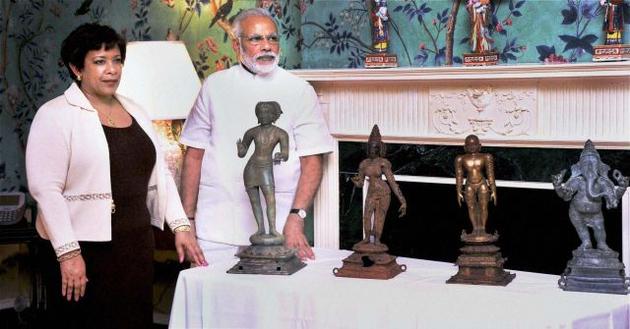
The raids have also underscored the need to expand India’s domestic enforcement efforts. The country’s only dedicated art police is the Tamil Nadu idol wing, led by Inspector General A G Pon Manickavel, is now chasing leads across India and international borders. The country desperately needs to develop a national police force dedicated to protecting its oft-purloined cultural heritage.
Government agencies should also work more closely with civil society groups like Kumar’s India Pride Project, which has worked tirelessly over the past years to identify stolen antiquities and bring them home, often while cajoling government officials to do more.
The willingness of Indian officials to crack down on the illicit antiquities trade within their borders will be measured largely by the aggressiveness with which they chase the leads they have gathered from Deena Dhayalan.

